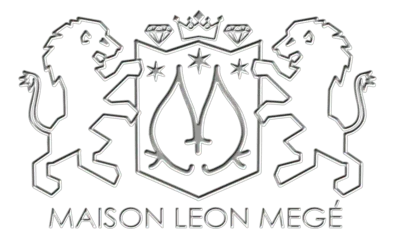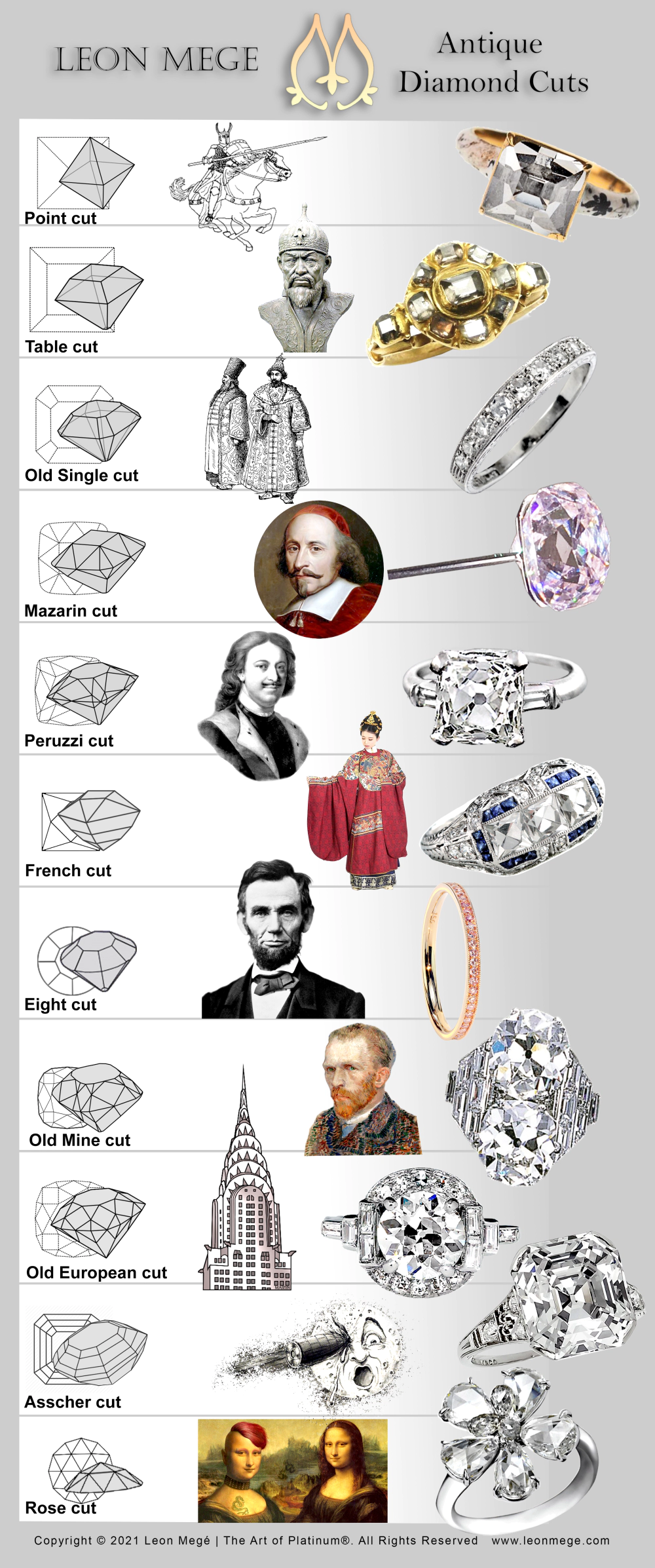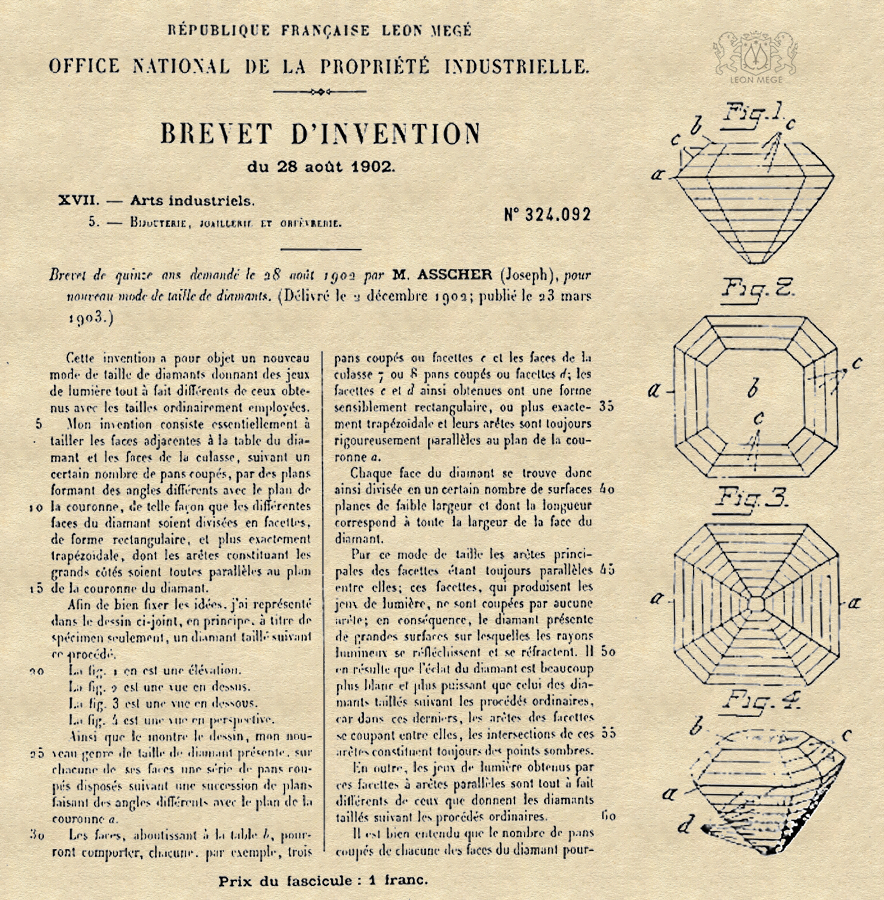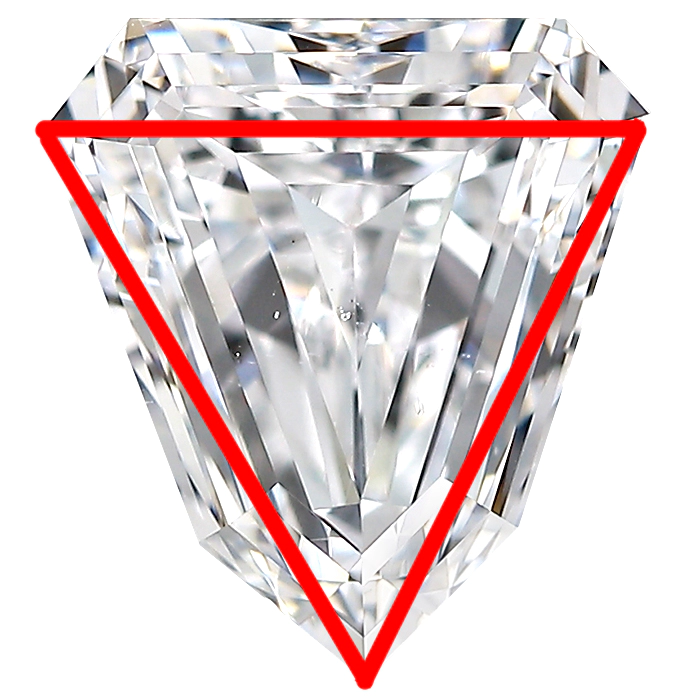- Modern
- Antique
- Side stones
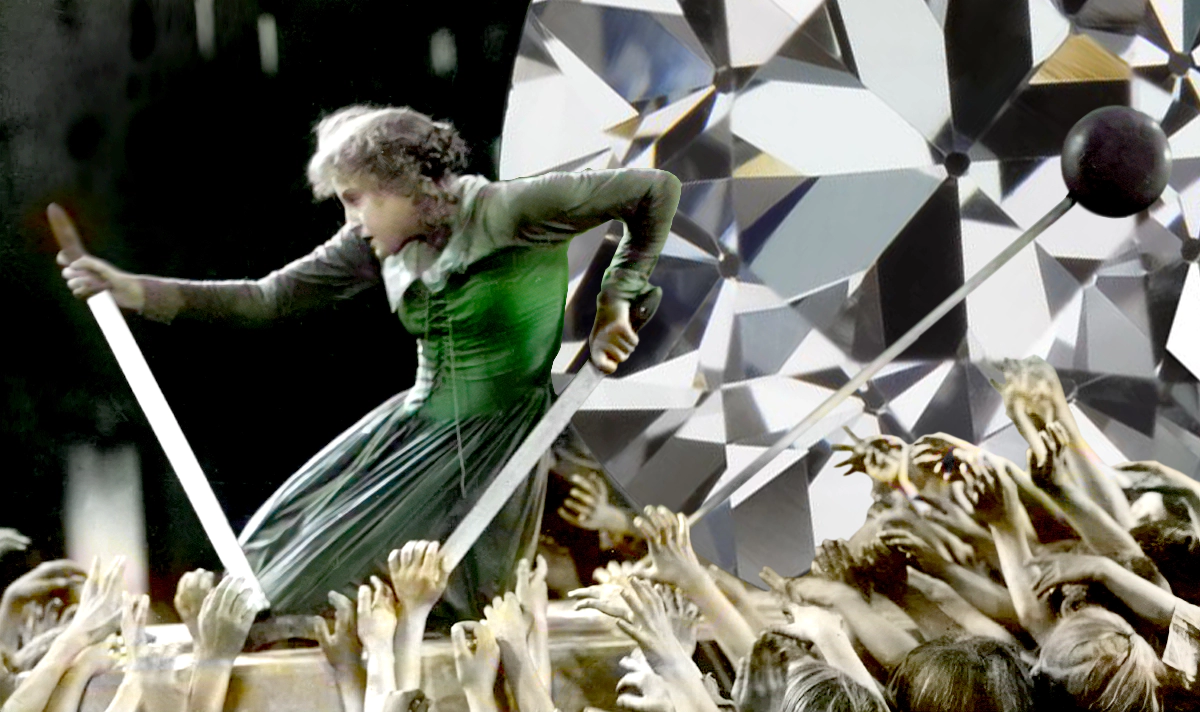
Modern diamonds offer the highest level of brilliance. But brilliance alone does not make a diamond beautiful. Plain-vanilla round brilliant is the most popular diamond cut but not because of its looks. Round is the easiest shape to standardize and work with. Modern diamond cuts are more expensive because the cutting process is more wasteful. A typical round brilliant weighs only half of the rough crystal it is cut from. The most efficient and atrocious-looking Princess cut fairs a little better, yielding about 60%.
Modern diamonds have superior scintillation, while antique cuts are best at producing dispersion. Antique cuts were designed to respond to candlelight with an explosion of fire.
Sparkle is a misnomer referring to a combination of diamond brilliance, dispersion, and scintillation. These properties depend on how the light is processed inside the stone and how it bounces back toward us. A diamond that sparkles” better excels at uniform light refraction and distribution. It has a strong contrast between areas of light reflection and absorption. It also depends on the proportion between the size of the facets and the stone’s size.
Round is the most expensive diamond cut. Choosing a fancy-shaped diamond can save you 20-30% versus a round diamond of the same size and quality.
Princess cuts and modern cushions offer the lowest per-carat price. The reason for the high yield is the way rough diamond crystal is shaped.
All one carat round diamonds have the approximately same size.
A serious deviation from standard proportion makes a round diamond look bad. Deep rounds called nailheads look dark and metallic. Shallow rounds are called “fisheyes,” the name speaks for itself. Unlike rounds, shallow fancy shapes can look surprisingly good when they are skillfully cut. Such stones are facing up big, sometimes twice as big as other stones of the same weight.
Fancy shaped diamonds that have a relatively shallow depth but do not look glassy beat a round diamond
Elongated ovals and pears tend to appear larger than a round diamond. However, the difference is superficial and should not be a deciding factor in stone selection.
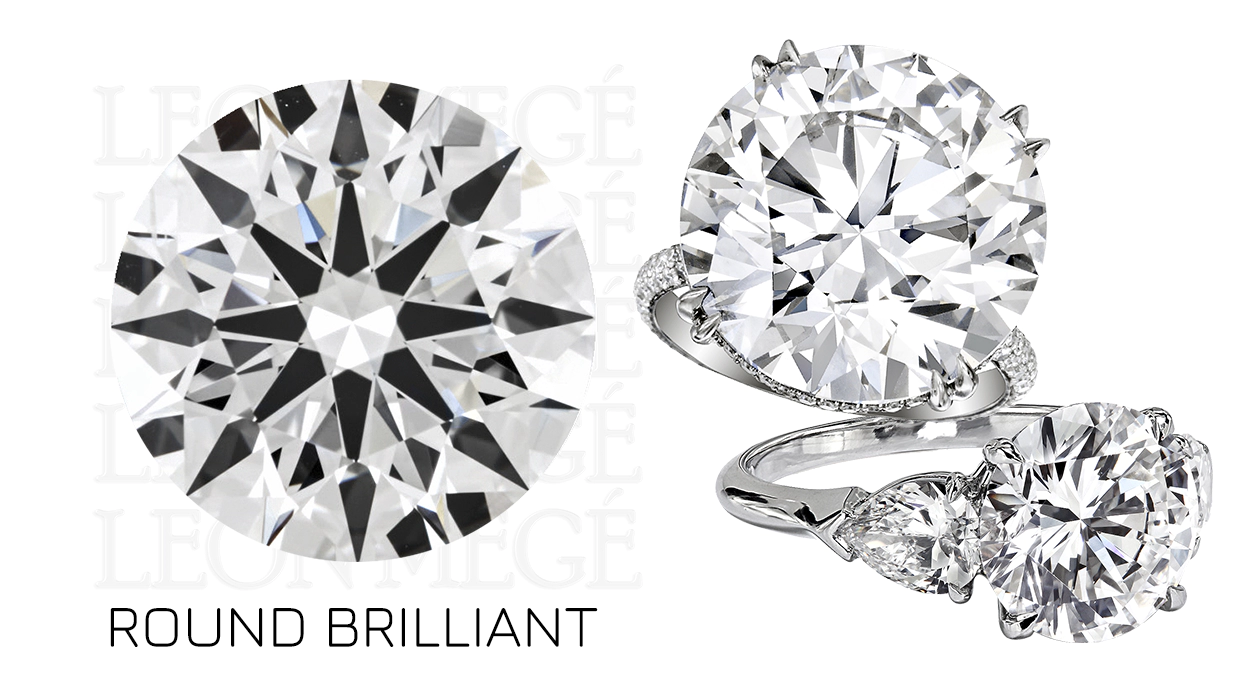
“Round” is a diamond’s shape, “brilliant” is a faceting style. Every round diamond has brilliant faceting, so round brilliant is the same as a round diamond. A round brilliant has 58 facets, 33 on the top and 25 on the bottom.
Round is not better or prettier than other diamond shapes.
DeBeers’ relentless advertising conditions us to associate the word “diamond” with the round shape.
Thanks to its eighth order of rotational symmetry, the round shape is best-suited for automated production, sorting, grading, standardization, and jewelry use. As a result, production speed takes priority over aesthetics.
In a world where diamonds became a commodity, the bestseller is always the one that appeals to the most people. The most versatile, non-engaging, and least imaginative is declared the winner to appeal to the average, esthetically challenged consumer. It is a vanilla ice cream of diamonds, bland and short on personality.
Round diamonds make up roughly 60 percent of all diamonds sold in the US. This percentage varies from state to state, for example, 73 percent in Maine vs. Louisiana’s 47 percent. It must be the weather.
Worldwide the percentage is even higher – roughly 75 percent.
For many decades Chinese and Russians living under Marxist regimes were deprived of fancy-shaped diamonds deemed to be an unnecessary luxury. Even today, they eye suspiciously any diamond that is not round.
An ideal depth percentage of a round diamond is roughly 59 to 62 percent.
Table size should ideally stay under 60 percent.
Pavilion angle is the most important metric and should be between 40 and 41 degrees. 46-48-degree angle typically gets a very high score on the Leon Mege index chart.<LINK>
The optimal crown angle is subject to personal taste. Typically 32-35 degrees is the sweet spot. The low angled crown contributes to the diamond’s marginally larger diameter. In terms of the look, we favor a steeper crown, as steep as 36 degrees.
These diamond proportions apply only to GIA-graded modern round diamonds, not other shapes or cuts.
Yes, OEC is a round brilliant. It has the same number of facets, but they are proportioned differently, resulting in a dramatically different look compared to a modern round brilliant.
Modern stones usually lack a facet on the diamond’s point called “culet,” common on Old European cut.
Like its brethren – the Antique cushion and the Asscher, OEC shows less brilliance but more dispersion or fire. It is not economically profitable to cut OEC stones today. Most of these stones come from vintage jewelry.
Round diamonds did not exist until the late 1800s. Then, one day an unknown barber in Amsterdam thought of applying the concept of a perfectly round head (every barber’s dream) to diamonds.
Using a lathe to produce a perfectly curricular diamond, he invented the “bruting machine.” But, unfortunately, the early machines caused fractures called “bearding” and bruises or “gletses” along the girdle. Faceted girdles appeared much later.
In the early 1900s, a rat race to invent the “perfect” diamond cut was fueled by the flood of South African diamonds into Europe.
The “Father” of a modern diamond cut was a Polish engineer Marcel Tolkowsky. He calculated the specifications of the new “American Standard” diamond cut. Using proprietary mathematical formulas that no one could neither understand nor repudiate, he claimed to find a perfect balance between diamond’s brilliance and fire.
The perfect diamond size for a round diamond is between 2.5 and 3 carats if you can afford it. This is the range when the size of its facets most optimal to a human eye.
Round cut diamonds have always been, and always will be, the plain vanilla ice cream of diamonds. Tastes good but lacking character. Round diamond size compensates well for its lack of personality.
However, a round diamond over five-carat starts losing its appeal. The bigger the round diamond gets, the more artificial it looks.

For centuries the classic cushion was the most common diamond cut, an equivalent of a present-day round brilliant. Its rising popularity in the early 90s ignited the cushion diamond cut revival that lasts until this day.
The modern surrogates of rare classic cushions flooded the market.
Modern cuts share antique stones’ pillow-shaped outlines, but their faceting is different.
The modern cushions are not quite as elegant as the classic cuts, but they are more brilliant and affordable.
There are three distinct types of cushion cuts. GIA classifies them into “Old Miners,” Cushion brilliants,” and “Cushion modified.”
Old miners have large “chunky” facets. The other two cuts have modern-style small facets. Cushion brilliants’ facets run all the way from girdle to culet, while modified cushions’ pavilion facets stop midway resulting in a nasty bulge. The bulge adds dead weight and can interfere with the ring’s design.
The original pillow-shaped classic cushion is called “old-miner.” It is usually referred to as an “antique cushion.”
Cushion brilliants are essentially modern round diamonds with a cushion outline. For an unknown reason, all shallow cushions are certified cushion brilliants, even those with antique faceting. A cushion brilliant is not a transitional cut between antique and modern cushions as often implied.
Modified cushions are cushioned-up radiants with rounded shoulders. Modified cushions are often affected by excessive brilliance resulting in a highly undesirable “crushed ice” look.
The majority of antique cushions sold today are new stones cut by a closely-knit family of diamond cutters in New York. On occasion, a few stones taken from old jewelry make their way into the market. However, those stones tend to have imperfect symmetry and outsized culets.
You can admire antique cushions in museum collections all over the world. Royal regalia, crowns, tiaras, necklaces are all encrusted with old miners.
High-end jewelers – Harry Winston, Graff, Leviev, Moussaieff, and others all favor the classic cushion diamond which is an antique cushion.
Antique cushions are in high demand. They do not have the dreaded “crushed ice” look typical of modern stones. Unfortunately, they are also scarce and more expensive to cut.
“Crushed ice” is the excessive brilliance without a contrast. Small facets and their arrangements are the reason behind the redundant reflections. Such stones essentially look like a piece of ice stepped on by someone. Most modified cushions have it; some cushion brilliants might have it as well.
Elongated modern cushions are essentially ovals with high shoulders. Like ovals, they can be afflicted with a bow tie, a darkened area in the middle of the stone.
You cannot go wrong with a cushion diamond set in a halo setting. A cushion cut works with all sorts of halos; smaller stones work particularly well with a double halo.
Radiant-derived modified cushions with bulging pavilions are ill-suited for solitaire or three-stone ring settings, especially those featuring pave on the basket. Modified cushions are hard to distinguish from a radiant cut when held in prongs that obscure the corners.
Cushion diamonds come in various length-to-width ratios, each suitable for a specific ring type. Cushion diamonds with a 1.5 and higher ratio are great candidates to be set East-West in a ring. Three- or five-stone rings tend to compensate for a long ratio visually stretching a stone sideways. The 1.2 to 1.4 ratio works well in a three-stone combination. Stones with a ratio less than 1.1 make excellent solitaire or a halo ring.
The ideal cushion is a myth, much like the Yeti or its North American cousin, the Sasquatch. The ideal cushion is the invention of disreputable dealers desperate to sell what should be considered an inferior product.
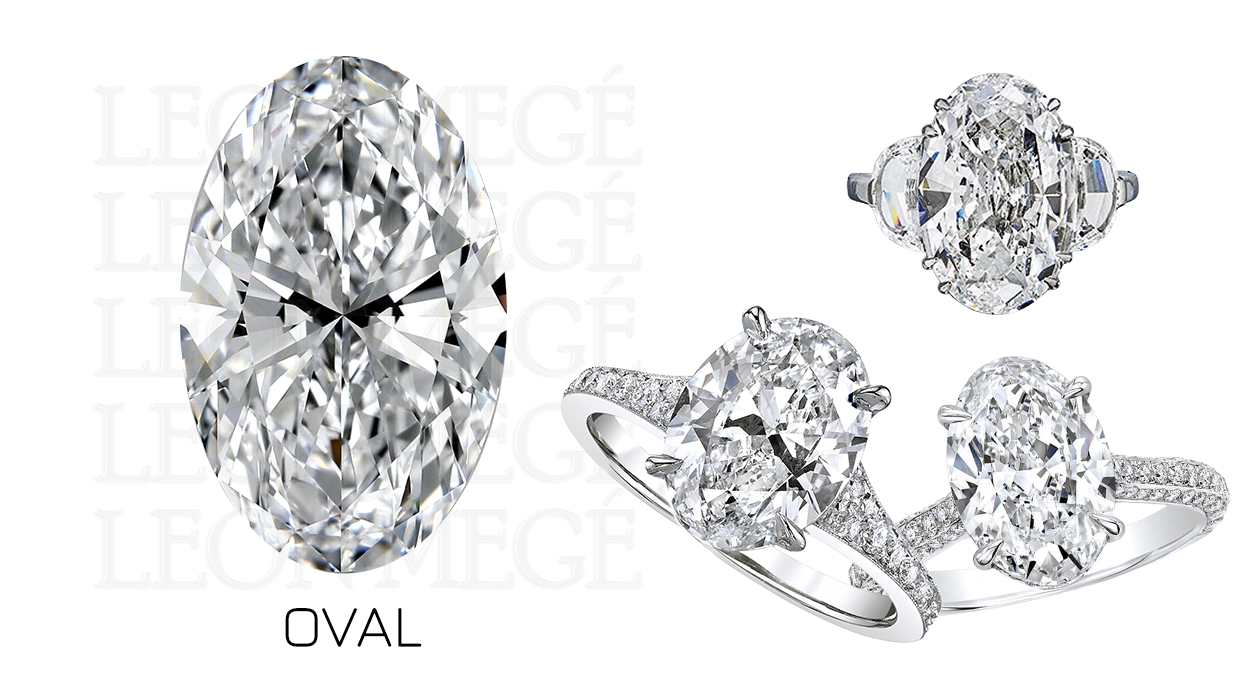
Oval’s elongated shape compliments the finger’s length while offering brilliance similar to a round stone. An oval diamond has a larger surface area than a cushion of the same carat weight because of the distribution of the material.
The best place to buy any diamond, including ovals, is directly from Leon Mege.
We have access to every oval diamond globally and guarantee the lowest price for any diamond you can find.
An oval diamond is an elliptical diamond with brilliant style facets. In terms of brilliance, an oval is very similar to a round cut. Oval diamonds tend to accentuate slender fingers and minimize the appearance of prominent knuckles.
In the late 1950s, a diamond merchant Lazare Kaplan pondered what to do with a pile of broken marquises. He decided to round off the tips and turn them into ovals, claiming the invention of something that already existed for centuries.
Oval diamonds were initially mistaken for poorly cut cushions and avoided. Today, it is considered one of the most beautiful diamond shapes.
The best choice for an oval diamond is a classic solitaire ring with four single prongs because the average oval diamond is 10% larger than the round cut.
A cathedral shank is the best option for an oval. It gives a ring the rigidity to withstand daily wear. The shank can be plain or pave set. Small ovals are used primarily as accent stones in necklaces and earrings. Ovals look spectacular accented with French-cut diamonds in legendary Leon Mege Mon Cheri ring style.
Wearing an oval isn’t just about the diamond. It’s about belonging to the exclusive club of the select few who dared. The oval shape signals one’s love for classic fashion and a heightened sense of individuality moderated by a devotion to tradition. It says you want to be different but not too much.
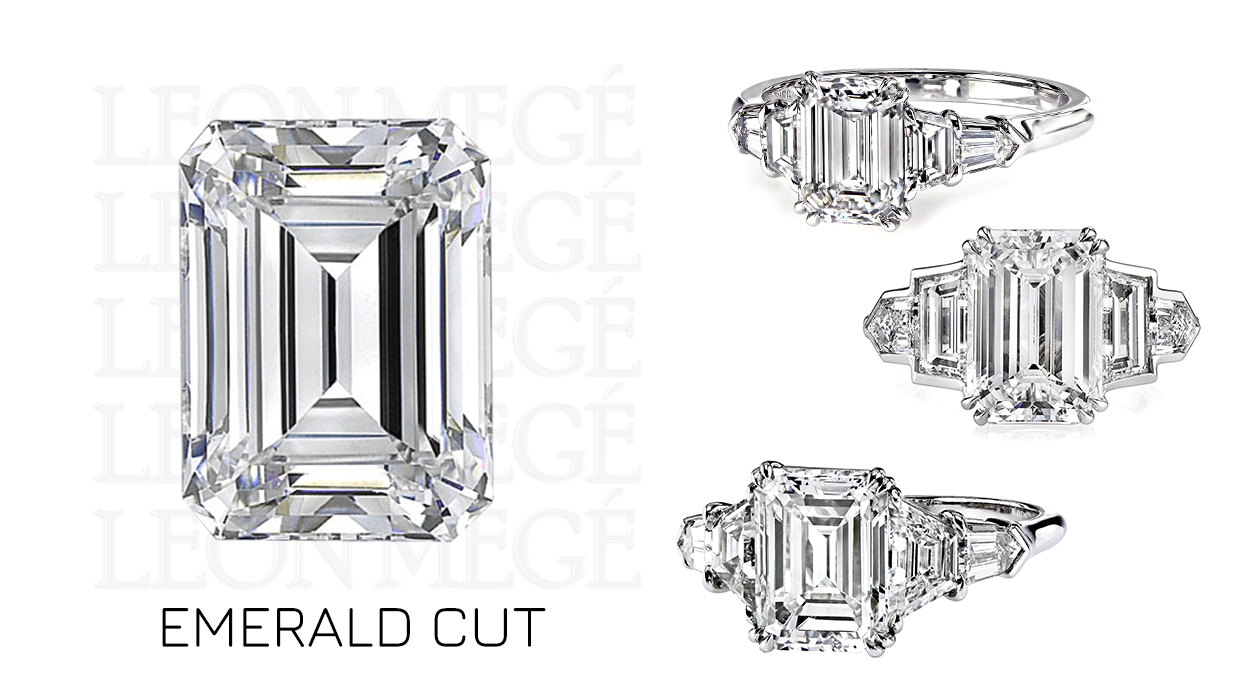
The emerald-cut diamond has a rectangular shape. Its straight linear facets are running parallel to its sides, and corners are truncated (clipped). A typical emerald-cut diamond has three rows of steps on both the crown and pavilion. There are 58 facets on a modern emerald cut.
Where the name “emerald cut” is coming from?
The cut is one of the oldest, its origins going back to the table cut of the 1500s. Before the 1500s, lapidaries were cutting green emerald gemstones using steps to reduce the pressure during the cutting process. In the 1920s, diamonds faceted in the same fashion (using parallel steps) became known as emerald cuts. The emerald cut diamonds exploded in popularity during the Art Deco era.
An emerald cut is known for its surprising affordability. As of March 2021, a natural three-carat emerald-cut diamond costs between $90,000 for the finest specimen and $30,000 for a decent commercial-grade stone. The price depends heavily on the number of stones available and other factors like cut or fluorescence.
An emerald cut is known for its intense fire, colorful rainbow flashes that illuminate a finely cut stone. It is one of the most elegant diamond cuts in the world.
An emerald cut’s length to width ratio is a matter of personal preference.
Emerald cuts in the 1.35 -1.4 ratio range seem to be the most common choice and work well with any engagement ring style.
Long emerald cuts of 1.5-2.0 are better suited for three- or five-stone rings.
A ratio of 1.40 to 1.50 is considered the most desirable. The longer and skinnier emeralds (1.5-1.65 ratio), and some prefer the shorter, squarer cuts (around 1.3)
The emerald-cut diamond is practical, versatile, upscale, and refined, excellent for classic and contemporary styles. Choosing an emerald-cut diamond announces to the world that you arrived and your sense of style is flawless.
It is loved by purists who love elegance, simplicity, and tradition all in one.
A good-looking emerald-cut diamond must have broad and prominent corners without chaotic reflections.
When facing up, emerald-cut diamonds are whiter compared to brilliant cuts. Emerald cuts higher than GIA K-color are entirely acceptable. Some actually prefer warmer colors for step-cut stones.
However, they are less efficient in hiding inclusions. The minimum clarity of VS1 is recommended.
Any shortcomings in emerald symmetry are clearly evident because of the geometry of step-cut facets. Any disruption in the pattern of straight parallel lines intersecting each other at predetermined angles is easily noticed even with an untrained eye. It is smart to look for a stone with a very good or, better yet, excellent symmetry.
Instead of a pointy culet, an emerald cut has a culet line called a “keel.” The keel line is recommended not to exceed the diamond width.
The keel’s length is vital because it determines the angle at which pavilion facets meet. A significant difference between the pavilion’s long and short side angles will result in a dark center.
The emerald cut is a perfect stone for a three-stone ring with trapezoids, bullets, or shields. However, the best-looking emerald cut ring ever is a five-stone ring with Balle Evassee diamonds. Balle Evassee is a combination of steep-angled traps and short bullet pentagons.
Shorter emeralds are perfect in solitaires and even surrounded by a very dainty micro pave halo.
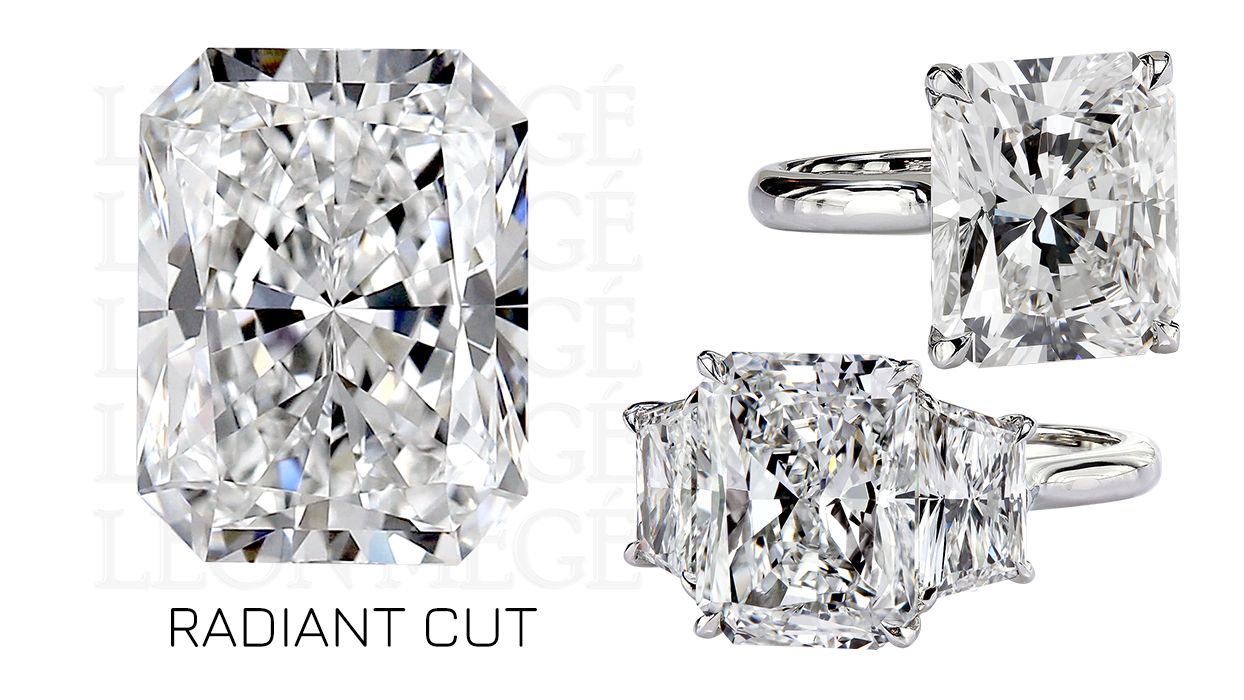
The radiant cut was developed with the goal of combining the round cut’s brilliance with an elegant shape of the emerald cut, with 70 facets giving it a remarkable ability to retain light and spit it back in a dizzy multitude of sparkles.
The radiant- and emerald cuts share the same outline – a rectangular shape with clipped corners. However, each has a distinct type of facet.
Both cuts look entirely different despite having identical shapes.
A radiant cut is a brilliant-cut with kite- and triangular-shaped facets radiating from the center. An emerald cut is a step cut; it has rectangular- or trapezoid-shaped facets running in parallel steps to each other.
An emerald-cut sophisticated look can be attributed to its intense fire bursting through its bold geometric facets. A Radiant cut trades fire for brilliance.
Radiant cut has the ability to improve the color intensity. Fancy diamond color has three components – the hue (primary color or a combination of two or more colors), tone (color’s relative lightness or darkness ), and saturation (the color strength).
Radiant cut has a dramatic effect on the fancy colored diamond’s tone and saturation.
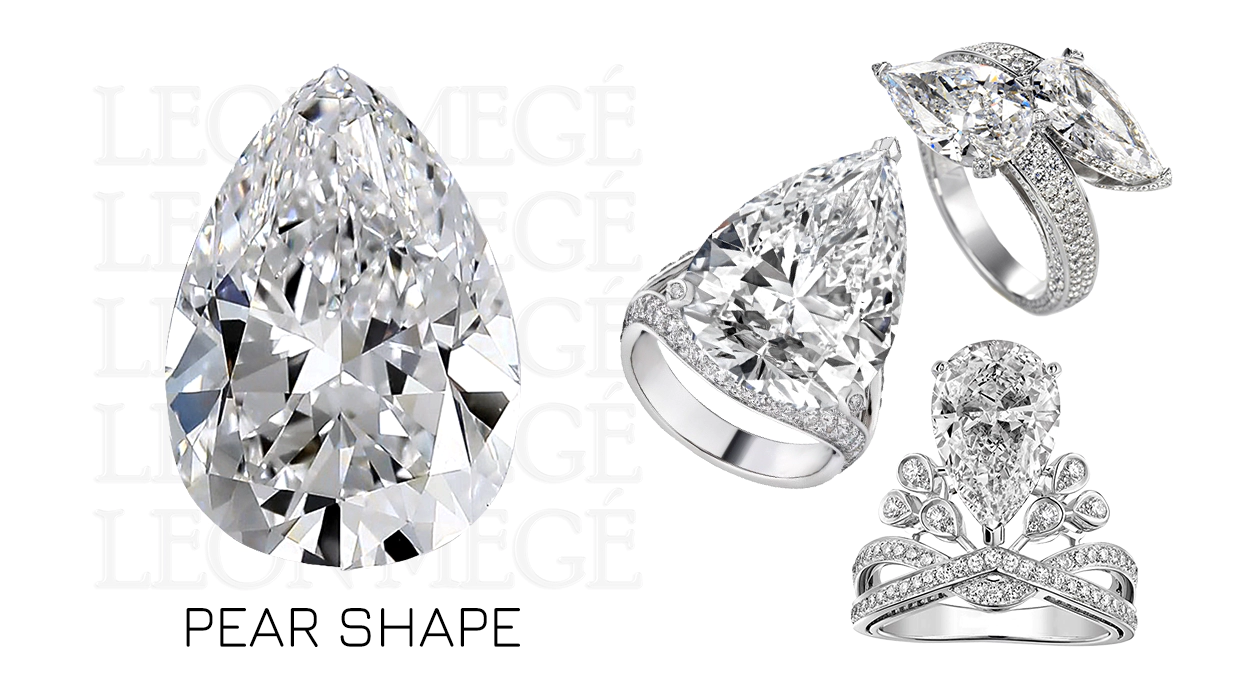
The pear shape is a unique diamond, a combination of a marquise on one end and an oval on the other. It combines the cuddly softness of a rounded outline with the dramatic exclamation of a pointy tip. Pear shapes are cheapest relative to rounds at one-carat size, but the difference in price decreases between pears and rounds as the size grows.
Properly proportioned pear-shaped diamonds are gorgeous and are in high demand for engagement rings. All elongated diamonds, such as a pear shape, tend to look larger than a round diamond. Pear is a less traditional choice of a diamond than, say, round or cushion. It is a unique cut and does not work for everyone. It’s a good idea to make sure that you will be enamored with it for many years to come.
The best ring style for a pear shape is a solitaire. The best side stones for a three-stone ring with a pear shape are baguettes and bullets. Half-moons are the absolute worst choice of side-stones for the pear shape. The pear-shaped halo is less popular. Elongated pear-shaped diamonds also look wonderful as drops in earrings and pendants.
A pear-shaped diamond is usually set with three or five prongs.
The pear’s tip is often set with a V-prong, though a claw prong on the tip is the better option. Sometimes, pears are set the old-fashioned way using two prongs on both sides of the tip. This destroys the elegance of the pear shape.
The point should face out toward the wearer’s fingertips instead of facing inward toward the wrist, mimicking fingernails. By pointing outwards, the pear shape makes the fingers appear slimmer.
Both shapes describe the same stone. A pear-shaped diamond has a rounded end on one side and a tapering point on the other. A teardrop is a very elongated pear shape with a length-to-width ratio that’s significantly over 1 to 1.5.
The most popular are elongated pears resembling the shape of natural curves of a sunflower seed. 1.5 to 1.7 length-to-width range is the most desired ratio. However, some people prefer much shorter ratios, especially for smaller diamonds.
Poorly cut pears can look crooked and have a bow tie. Pears with high or uneven shoulders decrease the diamond’s appeal and should be avoided.
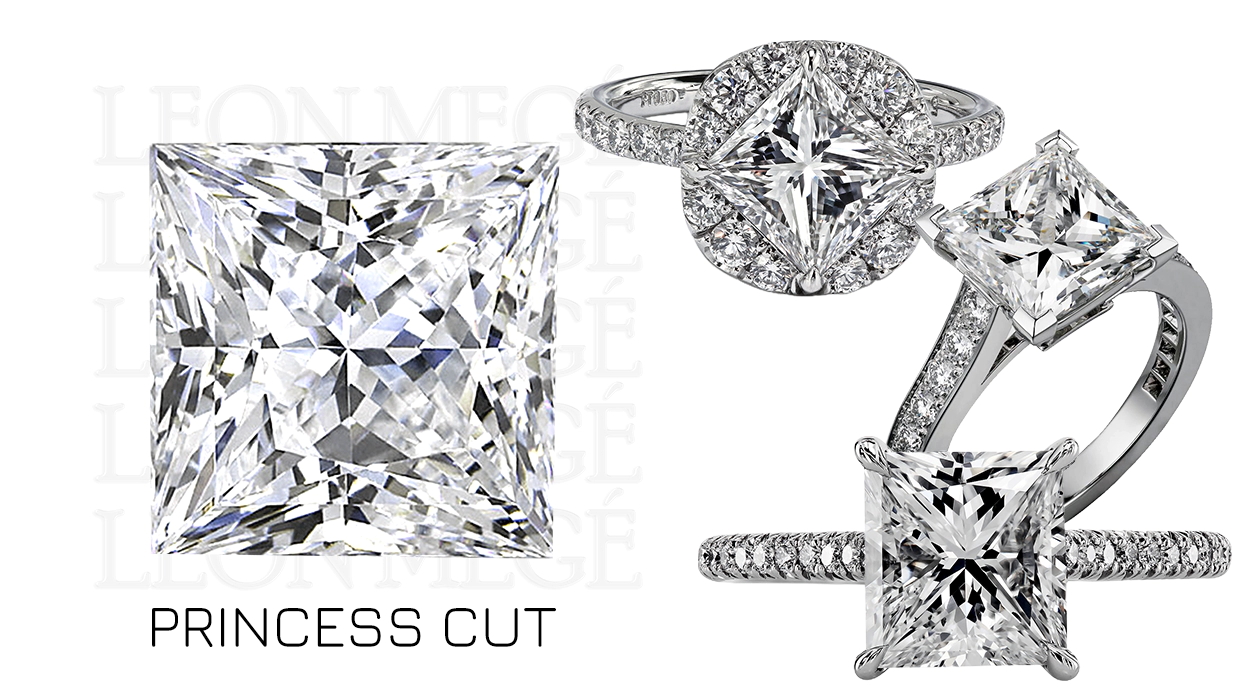
The princess cut is a modern, square, sometimes slightly rectangular, brilliant-cut stone with a large table, a low crown, and sharp corners. The princess cut has kite and triangular-shaped facets, just like a round brilliant but with all four sides cut completely straight. Princess cuts can have 58 or 80 facets since their number on the pavilion can vary.
The cut has a profusion of brilliance responsible for its jarring sparkle and shattered glass look.
The ideal length to width ratio of a princess cut is 1.00 to 1.05, 60% – 70% percent table and 65% – 75% percent depth. A lower depth and higher crown make a princess cut less appalling, albeit more expensive.
The princess is cut to maximize finished weight at beauty’s expense. As a result, most of them have wide tables, shallow crowns, and deep pavilions that conceal extra weight.
A princess cut’s pavilion facets are arranged in chevron-shaped rows. The number of rows ranges from 2 to 4. This is not unique to princess cuts; the Asscher cut also features a variable number of rows.
Ultimately, the difference in the number of rows has little effect on the look of the stone. Having more “chevrons” on the princess’s pavilion cannot improve its unfortunately revolting appearance.
The princess cut gained worldwide popularity thanks to its relatively low price and the tear-inducing blast of sparkle. As a result, the princess cut is the second most popular diamond in the world. In the US, it accounts for over 21% of all diamond sales.
Surprisingly, it’s not in New Jersey where princess cuts are most popular, but in Wyoming, with a 30% share. The princess cut is least popular in Washington, D.C., at only 11% of total sales. Commonly used in low-end jewelry, the princess cut is considered vulgar and unrefined for upscale pieces. As a result, most jewelry designers are apprehensive of using the princess cut, opting for Asschers, baguettes, and step-cut carre diamonds instead.
A popular and beautiful square brilliant – the French cut existed long before the princess cut took its place. The peak of French cut popularity was at the height of the Art Deco era. Unfortunately, it was expensive to produce as roughly a third of the diamond crystal was wasted during the cutting.
According to the market research, people clamored for a square diamond with a round cut’s brilliance. The answer was a “profile” cut that came into existence in 1961, when a London cutter Arpad Nagy sliced four sides of a round stone in an apparent fit of anger, turning it into a perfectly square brilliant with 58 facets.
In 1979, a group of Israeli cutters: Yigal Perlman, Betzalel Ambar, and Israel Itzkowitz created a similar-looking square brilliant-cut with fewer facets. Driven by the desire to create an affordable diamond cut, they gave it a shallow crown and deep pavilion. This innovation made it possible to produce two instead of one stone from a single piece of rough with very little waste.
The corners of a princess cut are extremely delicate and must be protected by prongs. The princess’ tips are prone to breaking even with regular wear. A broken tip cannot be repaired without the stone losing significant weight. It is recommended to exercise caution during daily wear or, better yet, to protect the stone by surrounding it with a halo.
Sharp corners are protected with prongs. V-prongs are marginally stronger than claw prongs but look too clumsy and metallic.
We recommend claw prongs on each of the four corners as the best way to set a princess cut. Those who say otherwise do not know what they are talking about and shall burn in a special section of hell reserved for bad jewelers.
Surprisingly, a princess cut looks natural in a bezel setting. Small princesses are often set in a channel.
It’s a good idea to protect the princess’s vulnerable corners with a halo. But, unfortunately, a square halo makes the princess cut even more revolting to look at.
So it’s ultimately best to set the princess cut in a plain classic or modern solitaire. The second best option is a three-stone ring with long tapered baguettes or a matching pair of smaller princess cut diamonds.
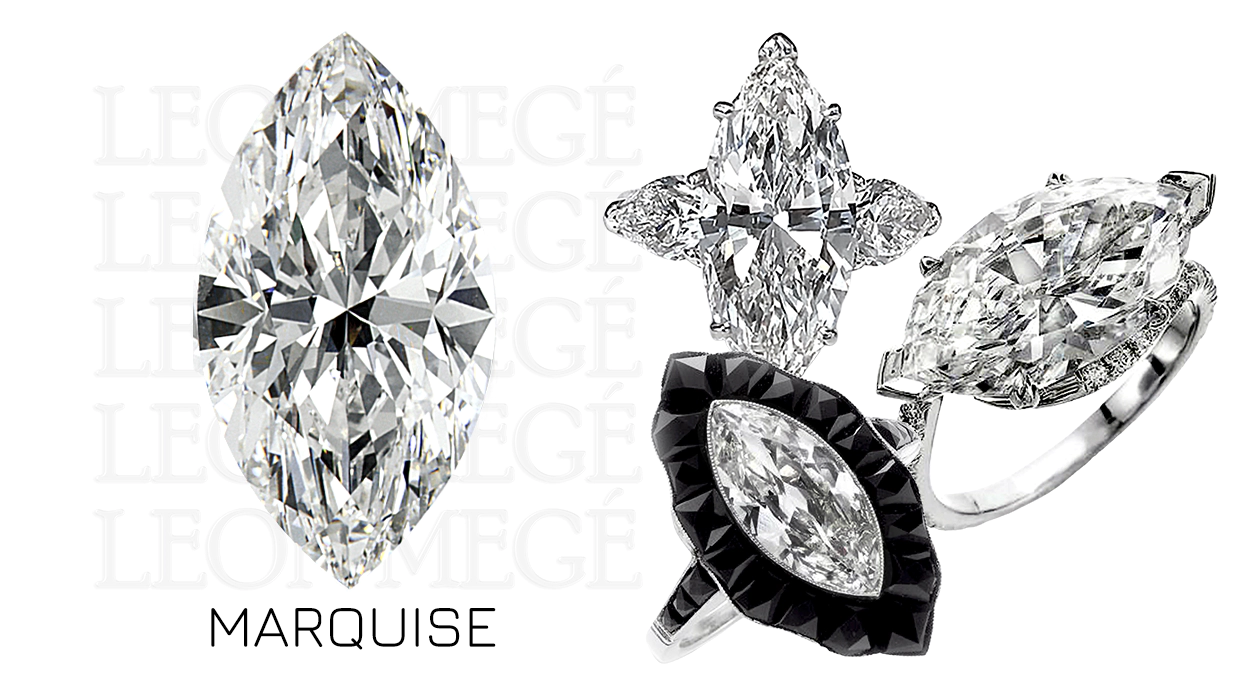
The marquise cut is an elongated elliptical shape with pointed ends. It generally has 56 – 58 facets, 33 on the crown and 25 on the pavilion.
There are several confusing terms for describing marquise’s parts.
The belly is the widest part of the stone; its wings are essentially what we call shoulders in ovals. Unlike an emerald cut where the keel is an elongated culet, marquise’s keel line is the edge running from point to point at the bottom of the stone. The tips are points where the two curved sides meet.
The French tip is a faceting arrangement on the stone’s end designed to improve the stone’s appearance and protect the point. The French tip is a premium feature of marquise, pear, and heart-shaped diamonds.
The marquise shape is very popular with gemstones like emeralds, rubies, and sapphires.
A beautiful slender diamond known as “navette” or “little boat” in French was renamed marquise in the 18th century because of French King Louis XIV’s indecent joke. He compared the alluring lips of his mistress, Marquise de  Pompadour, to the diamond’s shape. Thankfully, the “Sun King” didn’t get to match her other body parts to diamond shapes, or you wouldn’t want to be buying a round diamond today. So, in a sick twist, marquise diamonds became a badge of French nobility and were worn exclusively by those with a title of marquis or better.
Pompadour, to the diamond’s shape. Thankfully, the “Sun King” didn’t get to match her other body parts to diamond shapes, or you wouldn’t want to be buying a round diamond today. So, in a sick twist, marquise diamonds became a badge of French nobility and were worn exclusively by those with a title of marquis or better.
As Al Bundy put in his eloquent speech at Speakers Corner in London: “Am I alone in hating the French? No? I thought so.”
A bow-tie is a feature of any elongated diamond, including a marquise, that has a pointed culet. The effect is caused by the variable pavilion angle that goes from steep on the long sides to the shallow on the points.
The bow tie manifests itself as a darkened area across the center of the stone that is shaped like – you guessed it – a bow tie. The ghastly effect is mitigated by skillful faceting. However, a minor bow-tie is not detrimental to the marquise’s beauty.
All marquise diamonds have a bow tie, it’s just a matter of a degree. A weak bow tie even adds contrast and character to the stone.
A marquise is thought to have an oversized presence. Of all fancy cuts, it has the largest crown combined with a shallow pavilion. All shallow and pointed cuts, including marquises, pears, ovals, princesses, and hearts, face-up bigger than other stones.
A marquise with rounded tips is lovingly called “a moval,” a combination of two words, marquise and oval. They are typically antique stones featuring large elongated culets. Movals are very beautiful but extremely rare.
Navette is an old-fashioned name for a marquise diamond.
The optimal length-to-width ratio of a marquise cut is hovering around 1:2. The ideal depth is commonly quoted to be between 55% to 65%. However, deeper or shallower stones are lovely when skillfully cut. The size, position, and the number of facets are essential for a marquise’s beauty.
A marquise-cut diamond must be absolutely symmetrical. The marquise cut points should be perfectly aligned, and both sides should have a gentle arc without breaking point. Your jeweler should be able to calculate the ideal radius of the curvature with the simple formula κ= dT/dS where T is the tangent and S is the arc length, or by using the vector function
k= f ′′ (x)| / (1+ [ f ′ (x)]2)3/2
A marquise diamond’s pointed tips can snag and chip, so they should be protected by prongs.
The marquise cut is unique because it requires only two prongs to secure the stone safely. Except for very large stones, marquises are set with two prongs, one on each tip. Marquises can be set with V-prongs to emphasize their pointed tips and differentiate them from ovals.
Any diamond will compliment you, including the marquise, because you are beautiful.
Contrary to popular belief, fingers are not getting any longer if you are wearing a marquise.
The marquise cut, just like any other elongated shape, emphasizes naturally long fingers, drawing attention to their alien-like proportions. Small marquises actually make fingers look shorter.
Marquise diamonds look best when used as accent stones in clusters, often in combination with pear shapes and rounds. The leaf-like shape of marquises and pears makes them popular in stylized garlands and floral motifs.
Using marquises as the ring’s center stone makes sense only when the stone is fairly large. The best way to set a marquise diamond in a ring is as a solitaire with six prongs. In a three-stone ring, the center stone looks good flanked by skinny half-moons, bullets, and tapered baguettes.
Very long marquises set East-West across the finger are stunning.
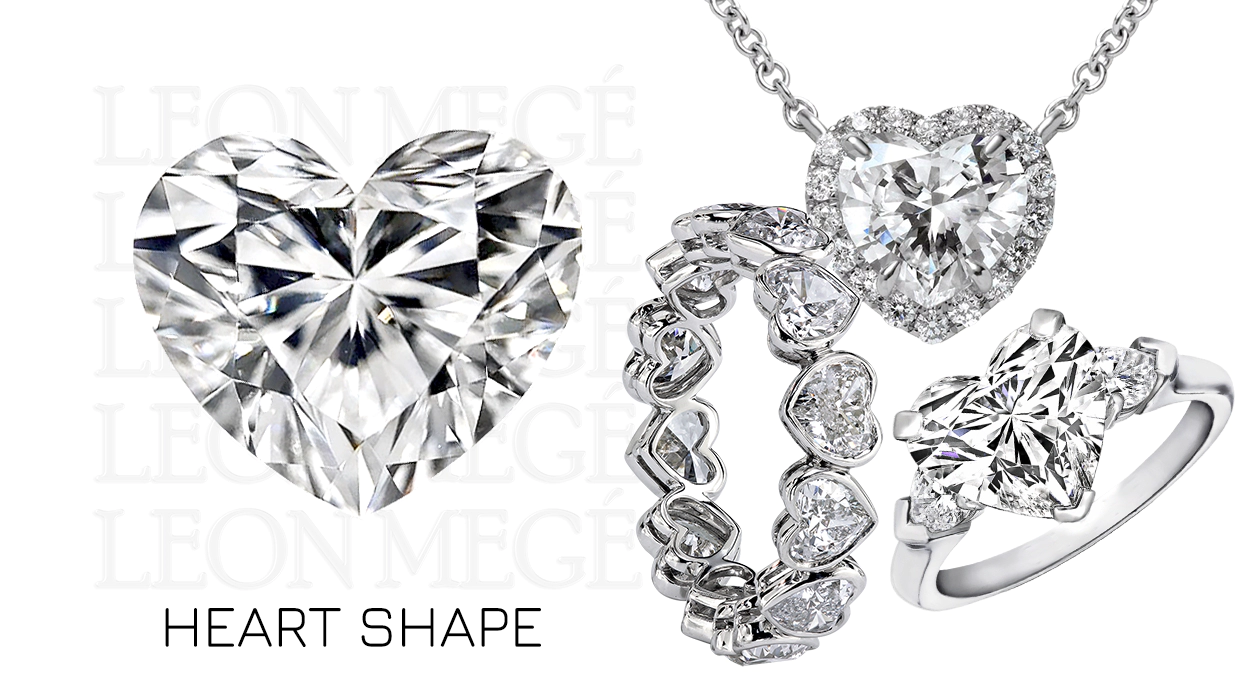
The heart-shaped diamond dates back to the late 1400s when this cut was considered a symbol of royalty. In a conversation with diplomat Nicodemo Tranchedini, Duke Galeazzo Maria Sforza compared the Medici dynasty to a heart-shaped diamond. Huh? The record keeper must have failed to mention the amount of alcohol consumed before he made that statement.
In 1562, Queen Elizabeth I received a heart-shaped diamond ring from her greatest rival, Mary Queen of Scots, in a gesture of peace and sisterly love. They spent the rest of the time plotting to kill each other.
French Cardinal de Richelieu, the Three Musketeers’ villain, owned a 20-carat heart-shaped diamond given to him as a bribe. In those days, men of power were not afraid to wear their hearts on their sleeves.
In 1972, Richard Burton gave Elizabeth Taylor a heart-shaped diamond with the words “Love Is Everlasting” scratched on its face in Parsi. The historic portrait diamond was set by Cartier into a pendant and bravely survived the slippery decolletage of the aging star into the 21st century.
The world’s most famous heart-shaped diamonds include a 30.82-carat fancy blue stone found around 1909 and initially owned by Cartier. It is called The Blue Heart. Another well-known diamond is the Heart of Eternity, a 27.64-carat Fancy Vivid Blue diamond unveiled by De Beers in 2000. The iconic 115.34-carat black Gruosi diamond is the fifth-largest faceted black diamond in the world.
Heart-shaped diamonds look best with a ratio of 1:1. Hearts outside of this ratio look stretched or squeezed. The heart shape has 56 to 58 facets typically, including 6 to 8 main pavilion facets. The table size is important since it has an impact on the overall brilliance and sparkle. The most desirable table is between 56 to 62 percent. The total depth should range between 56 to 66 percent.
The best heart-shaped diamonds have perfectly symmetrical lobes. The cleft (the inward-facing incision) must be crisp and smooth, with natural and even curvature. The pointed tip should divide the heart into two identical halves. A heart shape should be large enough to show off its shape as it can otherwise be mistaken for a pear cut.
The heart-shaped diamonds are usually set with three or five prongs. The tip is protected with a V-prong or a claw prong. Small hearts always have three prongs. We don’t recommend bezel settings. Diamond’s point should face towards the fingertips.
The heart-shaped diamond is the most romantic of all diamond cuts, so it’s a popular option for engagement rings and anniversary jewelry. Heart-shaped diamonds look best as solitaires and are also lovely when flanked by two smaller round brilliants. While this shape is considered tacky in the West, it’s very trendy in Asia.
The worldwide use of the heart symbol in art, cardiology, card decks, and silly Valentines turned it into one of the most popular non-geometric shapes, second only to the cross.
The heart was known as the vessel of love and the source of life since the time of the Pharaohs. The heart was the only organ to remain intact during mummification for use in rebirth.
The symbol representing the organ changed gradually over the course of history. Historians speculate that our symbol of love and affection evolved from depictions of buttocks, breasts, testicles, and even pubic mounds. Anything associated with reproduction is suspect, like the silphium seedpods used as a form of birth control in antiquity.
In Buddhism, the heart shape became the symbol of enlightenment rather than love. We want to think that our ancestors were inspired by something more cultivated than a set of reproductive organs, maybe a pair of swans bumping heads. After all, swans are monogamous.

Most people are intuitively attracted to antique diamonds because vintage cuts have a distinctly retro vibe. Unfortunately, lab reports fail to differentiate between modern and antique cuts. Antique cushions are called Old Miners, and the antique rounds are Old Europeans. Other shapes are not as lucky; you must examine them to determine whether they have modern or antique faceting. True antique diamonds are scarce; they come from disassembled old jewelry. Most antique cut diamonds sold today are contemporary replicas. This fact does not diminish their beauty and value.
The most recognizable antique diamond cuts are:
Antique Advantage
Antique cuts are angelic orphans looking for a new home. They are steeped in fascinating history and charming traditions. Antique diamonds bring us closer to our roots, filling us with a sense of belonging to a bygone era.
Every antique diamond is unique. Their artisanal individuality makes up for mechanical precision. Antique diamonds were designed when candlelight was the primary source of indoor illumination, making them burst with intense fire.
Antique diamonds offer timeless romantic appeal and dazzling fire. Unlike modern cuts, there are very few antique diamonds to choose from. An antique Asscher cut is undeniably the most beautiful of all antique diamonds. It is closely trailed by Antique Cushions and Old European cuts. The classic French cut is the absolute classic among accent stones.

In popular culture, Carrie of “Sex in the City” says yes to Aidan’s proposal with a stunning Asscher-cut diamond ring after rejecting a pear-shaped diamond in a gold mounting.
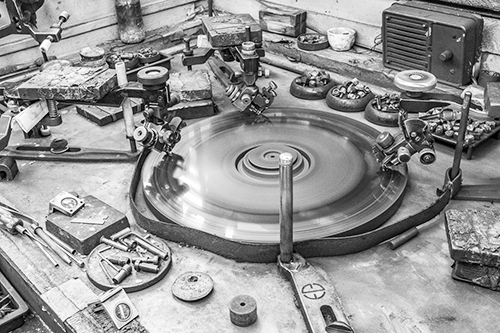
When you compare a vintage diamond to a modern diamond, it’s easy to see the difference. Should the charming past radiating from every facet of an heirloom diamond be destroyed to increase the perceived value?
The answer is: No. Old cut stones are genuinely scarce and only get rarer with every passing day.
A recut diamond is identical to a diamond produced from rough yesterday. Without a historical record, it’s impossible to tell when the stone has been cut.
Unfortunately, many of the world’s most famous and historic diamonds have been recut over the centuries of their lifetimes. Sometimes it was done to improve the appearance of stones, but more often to conceal their identity for criminal gain.
Asscher cut
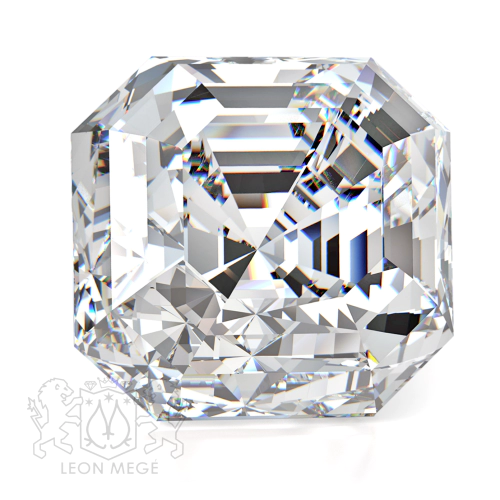
is the number of Asscher facets, however the Royal Asscher has 74 facets.
An Asscher cut diamond is designed to bring out the clarity of a diamond. It is a special cut highlighting a diamond’s luminous presence and elegance. Its step facets radiate from a culet to the girdle in an X-shaped pattern.
All Asschers, including vintage and antique stones, are classified as cut-corner square step-cuts. A well-executed Asscher rivals a brilliant cut in fire and even in brilliance.
Varieties of Asscher cut
The modern “Asscher” is a trade misnomer for an emerald-cut diamond with a 1:1 ratio. It has only one common trait with a real Asscher—step-cut faceting. The modern “Asscher” does not have the charm and appeal of the classic Asscher cut.
The classic Asschers are scarce because rough yields are meager, and there is a limited demand due to high cost and relatively small size-to-carat weight ratio.
Authentic antique Asschers are extremely rare and found in antique jewelry. They are almost octagonal stones with a very small table, high crown, and deep pavilion.
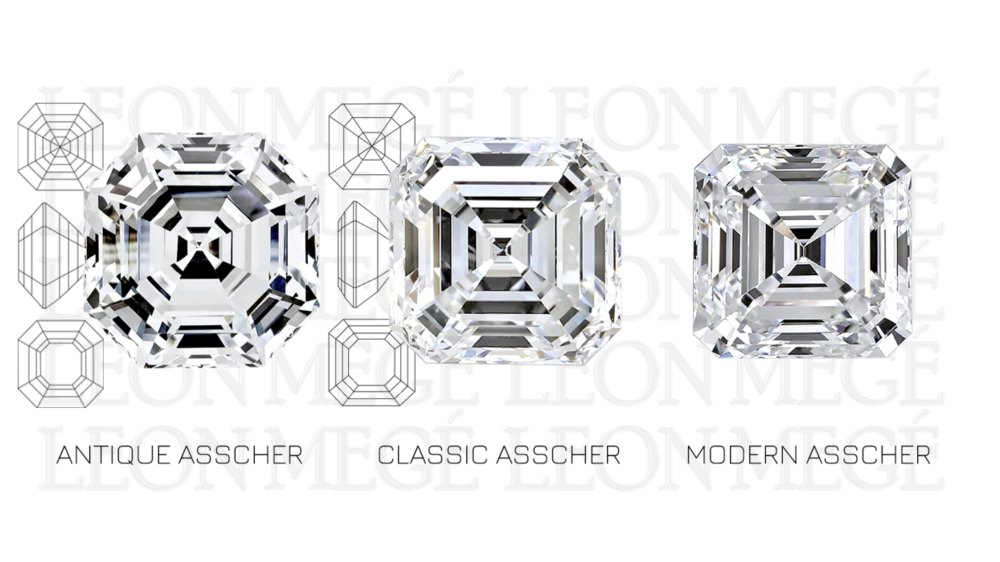
True Antique Asscher
Joseph Asscher created the world’s first patented octagon-shaped step-cut diamond in 1902. An Asscher cut diamond seems to draw the eye to the center of the stone, to its magical depth, and to the source of its incredible fire.
It is an octagonal cut with corners almost as wide as the sides, a small table, a high crown, and a deep pavilion. The table of an antique Asscher is typically less than 50%, with a total depth exceeding 70%, and with evenly spaced facet steps.
Antique Asschers are hard to find and usually come from estate jewelry. True Antique Asschers are modern replicas of the antique cut. Due to their scarcity, both the antique Asschers and their replicas command premium prices.
Selecting and buying Asscher cut diamond
- It is not true that low color will make the flaws in Asscher more visible. All antique diamond cuts tend to mask the diamond color and make it less noticeable. Warmer-colored Asschers look more natural and face up whiter than expected.
- The recommended minimum clarity for an Asscher cut is VS1 because the inclusions are easier to see in step cuts.
- The most desirable Asschers have very wide corners. They are nearly octagonal, bringing them closer to the original historical cut.
- Shallow depth benefits the larger look, but true Asschers are, by nature, deep stones.
- Real Asschers are deep, with a total depth exceeding 70%. Spreadier stones with 60%-68% depth offer a better size-to-weight ratio.
- Asscher cuts are not cut for brilliance but for fire.
- Make sure that your Asscher cut diamond has a GIA grading report. This is the world’s most respected diamond grading laboratory.
Classic Asscher
The Classic Asscher is a contemporary take on the antique Asscher cut. It mixes the wide-corner, small-table, uniform-facet concept with the low-crown, shallow-pavilion proportions of a contemporary emerald cut.
The Classic Asscher cut produced today is not as deep as the Antique cut. Its table hovers at around 60%, its depth is between 65% to 72%, its crown is lower, and the corners are not as wide.
Classic Asschers are reasonably priced, but they are in a limited supply and require a trained eye and lots of time and patience to distinguish them from modern Asschers.
Modern Asscher
A square emerald cut diamond, often called Asscher in the trade, lacks the mysterious elegance and finesse associated with the true Asscher cut. These stones usually have tiny corners, a shallow less than 70% depth, and a large table exceeding 60%. To call this cut Asscher is, at minimum, misleading, and there is very little value in buying such a stone.
Royal Asscher®
Royal Asscher® is a patented cut with two additional pavilion steps sold at a steep premium. They are laser-inscribed with the brand logo and an identification number. The Royal Asscher® brand name is printed on the certificate.
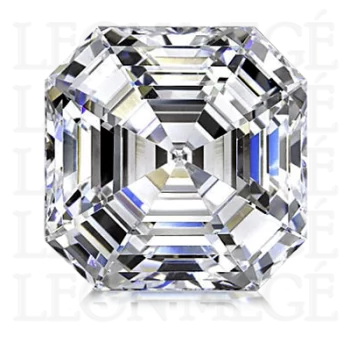
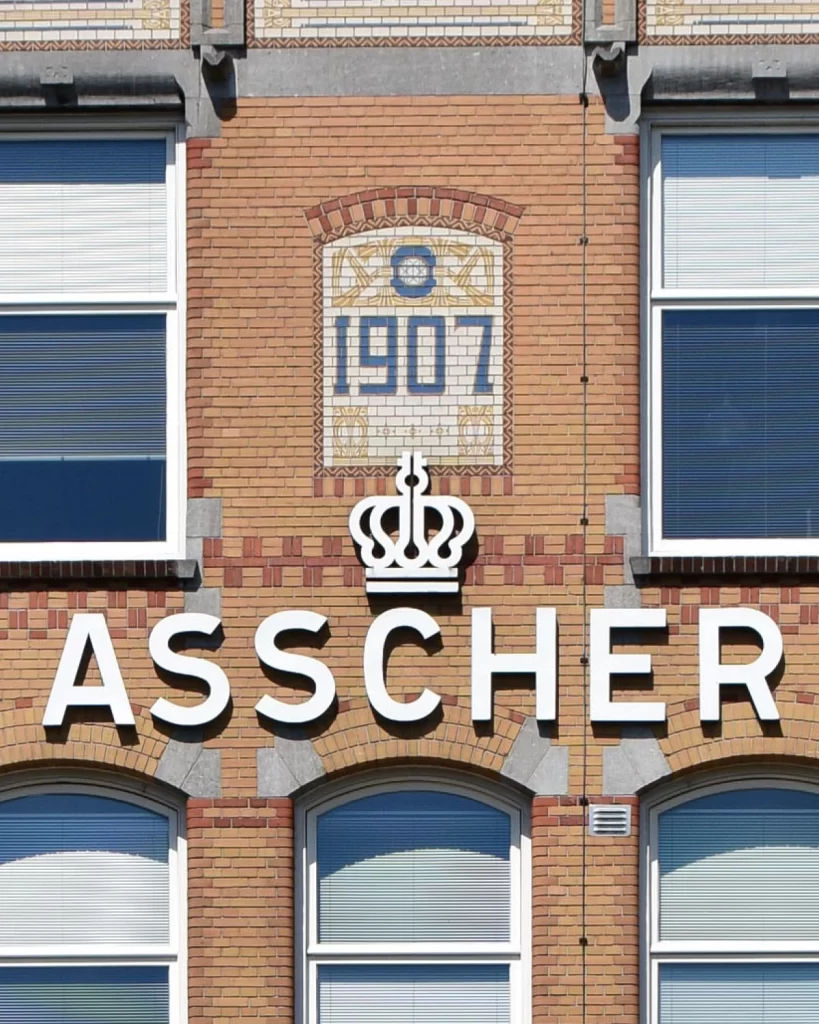
Asscher’s venerable name origin
The Asscher cut was created by the diamond cutter Joseph Asscher. His Royal Asscher Diamond Company Ltd. was established in Amsterdam in 1854. The extended Asscher family is renowned for being excellent diamond cutters and polishers. They work with hard-to-cut odd-shaped rough and are known to produce beautiful gems.
The Asscher factory once employed 500 people. In the old days, polishing wheels powered by steam engines were attached to long shafts with leather belts. The driving shafts ran the entire length of the building. Even after the introduction of electricity, the original shafts were retained.
Joseph Asscher
Joseph Asscher, the founder of the Royal Asscher Diamond Company, is famous for cutting two of the largest diamonds in history: the 995-carat Excelsior and the 3,107-carat Cullinan. Joseph was a third-generation diamond cutter in Antwerp who inherited the family business founded by his grandfather Isaac Joseph Asscher in 1854.
The story of Cullinan
King Edward VII contracted Joseph Asscher to cut the Cullinan diamond stolen by the British from indigenous Africans. Joseph studied the enormous piece of rough for six months. He finally notched a groove at a carefully calculated spot in preparation for the big moment. At precisely 3:05 pm, he took a shot of Jägermeister, mumbled something in Yiddish and hit the cleaver, and immediately passed out. After regaining consciousness, he learned that the stone split into three pieces, all according to plan. Was it stress or too much Jäger responsible for his fainting? We’ll never know.
Joseph fashioned the Cullinan into 21 gems, ranging from less than a carat to 70+ carat rocks. The stones cut from the Cullinan diamond, all flawless, are exhibited at the Crown Jewels collection at the Tower of London.
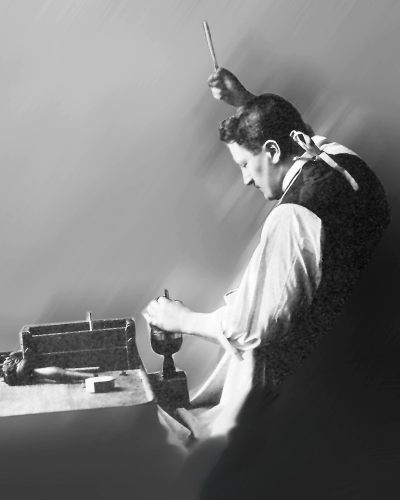
Classic or Antique Cushion
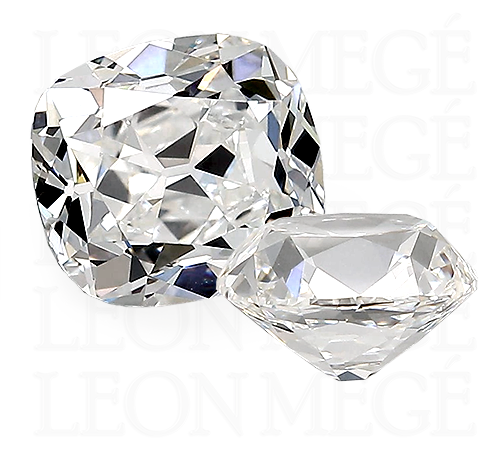
Classic (Antique) Cushions are rare, timeless, and sophisticated jewels. In the trade, they are known as Old Miners. The Antique Cushion’s high-contrast faceting mutes color perception, so it looks whiter than its modern counterparts. The Antique Cushion’s prized mix of fragmented brilliance and extreme dispersion is also unmatched.
Cushion Brilliants are essentially round brilliants with a pillow-like shape. Their pavilion facets originate at the culet and extend to the girdle in a star-like fashion. A stone loses its spot on the top of the cushion’s Mount Olympus and becomes Cushion Brilliant when it matches at least three of the following criteria:
– the table is over 53%
– the crown angle is over 40°
– lower halves are 60% or less
– the culet is slightly large
Cushion Modified combines radiant-cut facets with a cushion-shaped outline and soft, rounded corners. Modified Cushions have excessive brilliance without contrast, giving them a “crushed ice” look. Some facets terminate below the girdle. In places where the facets meet, they form bulges that complicate the ring’s construction and carry dead weight.
Antique Cushion
The traditional Antique cushion-cut diamond is a beautiful jewel. It has a pillow-shaped outline, soft, rounded corners, an open culet or a keel, a small table, and a high crown. The Classic Cushion comes with Old World flair and romantic appeal. Antique cushions are not necessarily old; Most antique cushions sold today have been recently cut.
The Antique Cushion was the dominant diamond cut for centuries until the advent of the modern round brilliant, which is uniform, scalable, and easy to make, sort, and use. Antique Cushions revived and recaptured the magic of the Golden Era.
Antique cushion diamonds have superior dispersion and radiate an abundance of fire when lit by flickering candlelight. They have an open culet, a high crown, and large facets—a perfect combination of sophisticated elements for a connoisseur seeking a diamond with character and pedigree.
Antique cushions are closer to step-cut diamonds in how they transform and return light. They don’t have the dreaded “crushed ice” look of modern cushions.
GIA classifies Antique cushions as Old Mine brilliant or Cushion brilliant depending on the crown, table, and total depth proportions.
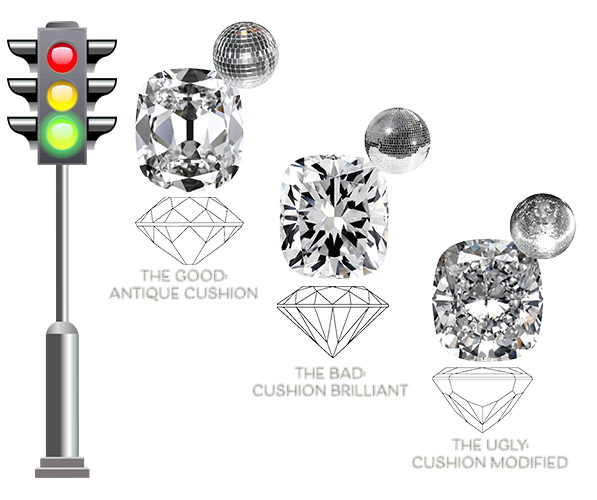
Old European Cut – OEC
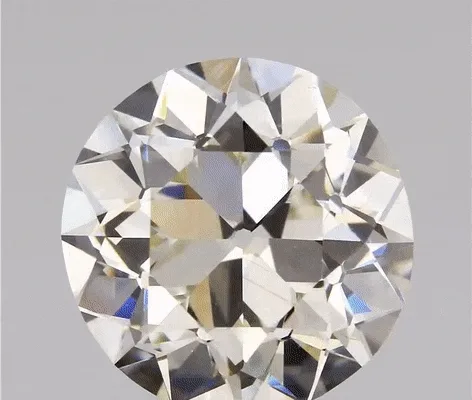
The Old European (or simply European) Cut is a vintage Round Brilliant. It became popular in the late 19th century when its predecessor, the Old Mine Cut, lost its Cushion shape and became round thanks to the invention of the bruting machine. The Old European Cut retained the rest of the Old Miner’s charms – the high crown, small table, and open culet.
The Modern Round Brilliant is a direct descendant of the European Cut. Both have the same round shape and 57 facets, not counting the culet. The proportions and angles have, however, changed drastically.
The current proportions of the Modern Brilliant inspired Marcel Tolkowsky, Henry Morse, and others to experiment with angles and facets, searching for the ideal round cut.
Today, Old European Cut diamonds are found in vintage jewelry. They usually have poor symmetry, often confused with old miners.
What makes Old European cut special? Like its predecessor, the Old Miner, the OEC features spectacular “inner fire” by design. When warm, flickering candlelight illuminated the 19th-century ballrooms, the Old European’s dramatic inner fire was a diamond’s most desired property. In later decades, when wearing diamonds outdoors became common, the emphasis shifted to cuts that maximize brilliance rather than fire.
- Old European Cut diamonds have small tables and relatively high crowns.
- There is always an open, often a large culet. The culet size may vary, but it is usually large enough to be seen with a naked eye.
- The Old European diamonds are not perfectly round. Cutting diamonds by hand often resulted in an off-round shape.
- The girdle of the old-euro is usually bruted. Its frost-like appearance is different from the clear faceted girdle of a modern diamond.
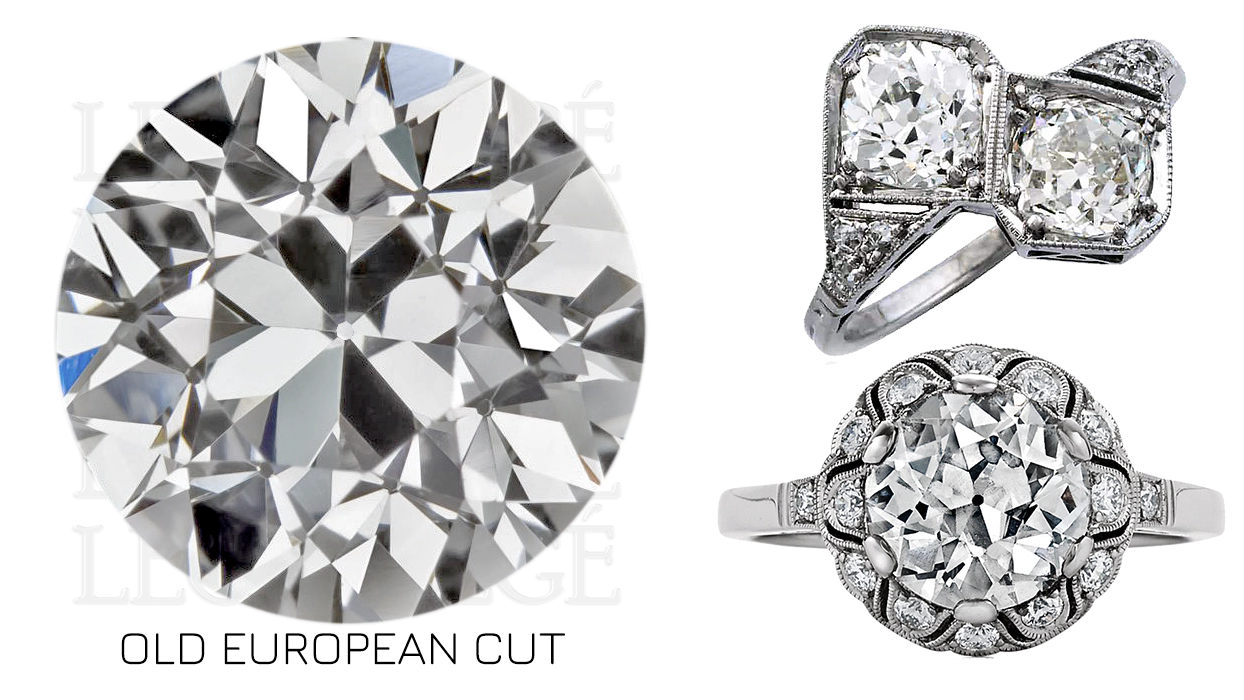
A Round diamond has to meet 3 out of 4 benchmarks to be certified as an Old European Cut by the GIA:
- A table size of less than or equal to 53%
- A crown angle of 40 degrees or more
- A lower-half facet length of 60% or less
- An open culet
GIA treats an Old European diamond as a fancy shape and does not evaluate its cut. However, Old Europeans are considered to be Round Brilliants in the diamond trade. The round shape is significantly more expensive than any fancy shape. The first brilliants, known as “Mazarins,” were introduced in the 17th century. Uniform diamond cuts did not exist until then, so each diamond had highly irregular shapes and a jumble of facets.
Before the invention of the diamond saw, a single piece of rough yielded just one stone. To maximize the yield, the European Cut was given a high crown, a small table, and an open culet. Skill and experience, rather than machinery and automation, give the Old European Cut a beautiful, organic, artisan look. The imperfections add character and timeless charm that only one-of-a-kind diamonds possess.
Old European Cuts are no longer produced. They are a prized find by collectors and history buffs.
The Transitional Cut
The Transition Cut also called the “American cut,” is a short-lived bridge between the Old European Cut and the Modern Brilliant. The experimental cut hosted a mix of modern and antique features in the same stone. The cut was invented in the 1870s by a Boston cutter and possibly a Red Sox fan. His name was Henry Morse, not to be confused with Samuel Morse, the inventor of the Morse code systems. Henry told everyone that a diamond’s beauty is more valuable than the rough yield. His goal was to find the most flattering proportions that return maximum light from inside a diamond. The diamantaires before him always strived to waste as little rough as possible during cutting. Henry, however, decided to go against the grain and waste as much rough as necessary to achieve the most sparkle.
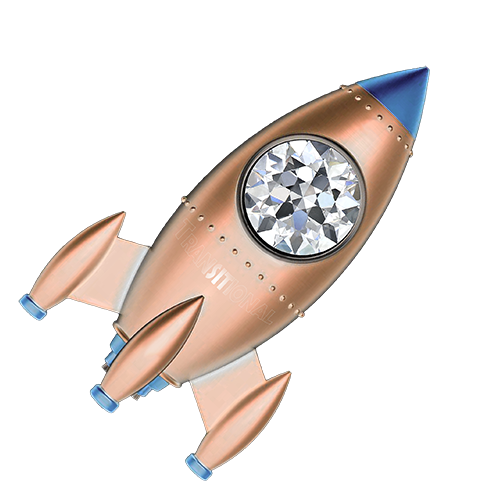
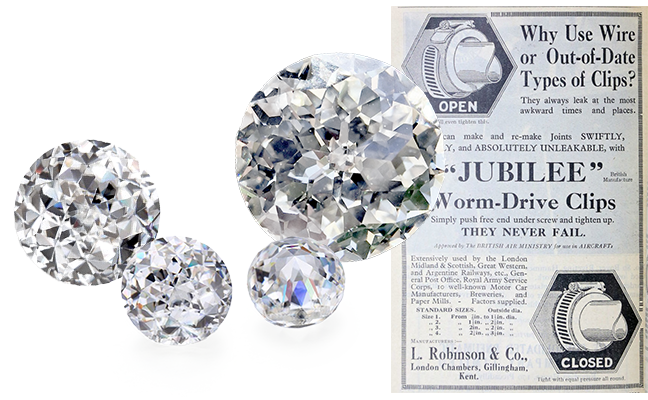
Jubilee cut
The Jubilee diamond cut is usually reserved for large diamonds. The elaborate faceting empowers a diamond to shine spectacularly. Compared to the Round Brilliant’s 58 facets, the Jubilee cut features 88 (sometimes 80) facets. Because it’s not deep and has no culet, the Jubilee has a glittering effect second to none. It is one of the brightest cuts you can find and is also extremely rare.
The Krupp cut
The traditional classic Asscher is a square cut with a length-to-width ratio of approximately 1.00 to 1.06. The Krupp cut is an elongated Asscher with a ratio longer than 1.1. The Krupp cut name comes from the emerald-cut diamond Richard Burton gave to Liz Taylor. Here is the diamond’s story.
In the early 1950s, German actress Vera Krupp, the trophy wife of a wealthy German industrialist, received a massive emerald-cut diamond with wide corners. Vera divorced her wealthy husband, kept the diamond ring he gave her, and moved to Las Vegas from Germany, breaking bad and partying around the town.
In 1959, the ring was taken from her at gunpoint during a robbery at her ranch. The FBI got involved because there was nothing better to do at the time at taxpayers’ expense and found the diamond at (of course, where else) a New Jersey grocery between mounds of mutz and gabagool. After the ring was returned, Vera became paranoid and pinned it to her bra strap at all times. When Mrs. Krupp passed away, the 33.19-carat diamond was sold to Richard Burton for $300k, who presented it to Elizabeth Taylor as a surprise gift.
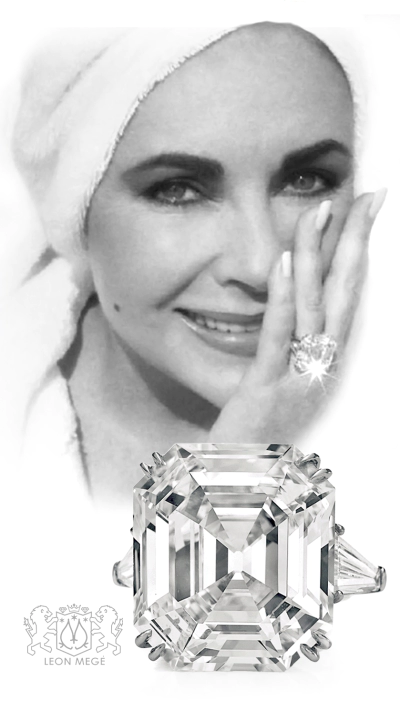
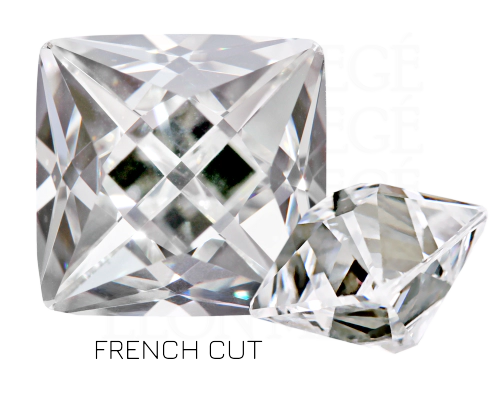
The French cut
The French cut diamonds originated in the 14th century, named so because of their popularity in France. They evolved from the old Table cut. The Scissors cut is a variety of French cut with a slightly more elaborate faceting.
A French-cut diamond can be easily recognized by a rhomboid table turned 90 degrees to the diamond’s outline. The shape is usually square but can be rectangular or even trapezoid. The pavilion of a French-cut diamond is split into four plain facets, sometimes divided in half.
A French cut has a small table created by slicing one end of a well-formed octahedral crystal, and its edges have smaller facets added for extra brilliance.
French Cuts are a rarity because they are primarily found in antique jewelry. Currently, there is a very limited production, mainly from a rare type of diamond rough – the well-formed octahedral crystals. Unfortunately, the yield is low, which results in a higher per-carat price. Top jewelry houses quickly absorb the small quantities available, making sourcing French-cut diamonds on the open market nearly impossible.
Another factor limiting the broad adoption of French cuts is their lack of uniformity. The French cuts are mainly used as accents in groups called layouts, not individually, but the lack of uniform proportions prevents using them in calibrated layouts.
The French cut is a result of the evolution of the primitive Table cut diamond into a marvel of elegance. The French cut came into fashion in the 17th century and has been used in high-end jewelry ever since. French jewelers favored these diamonds, hence the name.

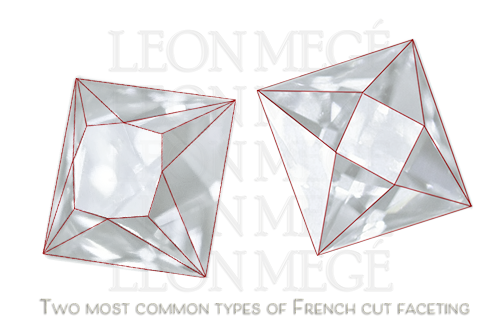
Antique-style French cut diamonds are produced using a well-formed octahedron rough. Modern French cuts are often produced by recutting baguettes and princess cuts, which have a low crown and a large table.
The French Cuts were extremely popular at the beginning of the 20th century during the Art Deco era featured prominently in the works of the top jewelers at the time. The Art Deco movement, with its emphasis on the pure geometrical forms, provided fertile ground for the wide use of French cuts in jewelry designs.
Princess and French cuts are distant relatives. They share a similar square outline. Facet’s arrangement, however, is completely different. While the French cut has charisma and elegance, the Princess cut is a square peg in a round hole.
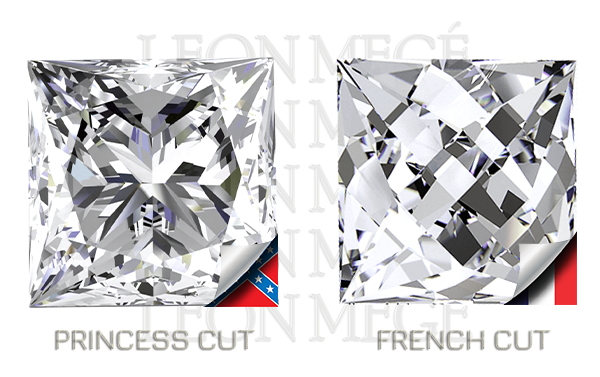
Rose Cut
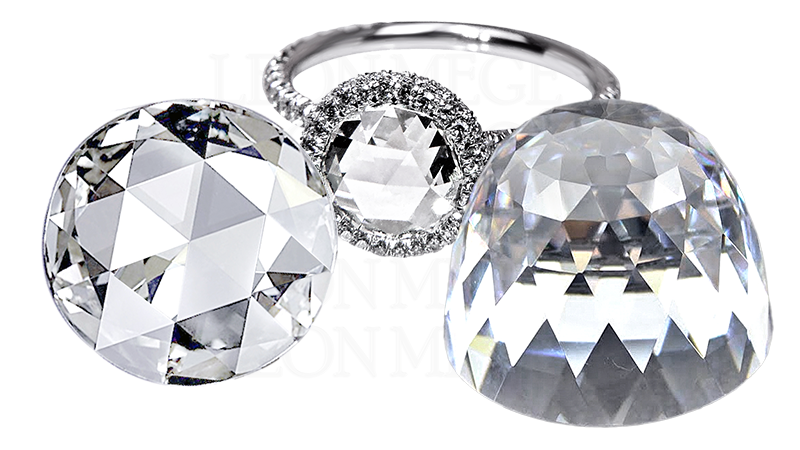
The Rose Cut is one of the oldest diamond cuts. It became widespread in the 1500s and remained popular until the early 1900s, when more complicated and precise cuts were developed. Picture a flat round diamond with a bulging pavilion and a giant table. Flip it upside down, and you’ve got a rose-cut diamond. It’s equivalent to a cabochon in diamonds.
Owing to their shape, carat-for-carat Rose Cut diamonds face up larger than any other diamond cut. This makes the Rose Cut an attractive purchase for those harboring a beer budget and a taste for vintage wine.
The crown of a Rose Cut is dome-shaped, formed by the facets meeting at the center. Because of its flat bottom and shallow depth, the rose cut reacts very differently to light than other diamonds. The absence of a pavilion results in washed-out luster and dull brilliance.
A rose-cut diamond crown has six triangular facets that resemble the petals of an unfolding rosebud. Perhaps having a drink can help you make the same connection. A conventional rose-cut diamond crown has six triangular facets arranged in a hexagon and small triangular facets completing the second row. Large stones have as many as seven or eight rows of facets.
Rose Cuts come in many shapes, although the majority are round.
Variations include the Briolette, a hexagonal Antwerp Rose, and a Double Dutch Rose, which resembles two Rose cuts united back-to-back. A Rose with a large table is called a portrait diamond. Rose-cut diamonds are timeless. They are a pretty cut that gives any jewel a unique vintage feel. Rose-cut diamonds can be used in any piece of jewelry and are exceptionally graceful in earrings, pendants, and necklaces.
The Rose Cut enjoyed a resurgence in popularity when Jennifer Anniston received a proposal with an eight-carat rose-cut solitaire, which sparked a short-lived renaissance. It’s still trendy and widely used in inexpensive fashion jewelry.
Rose-cut diamonds share proportion and faceting but come in many different shapes. The most common are round rose cuts, but there are also pears, cushions, and ovals.
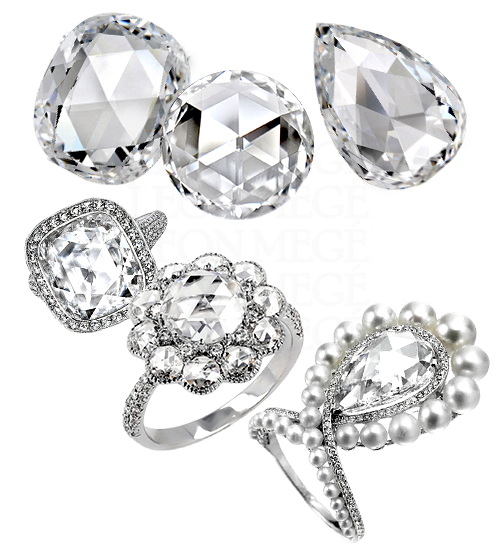
Single cut
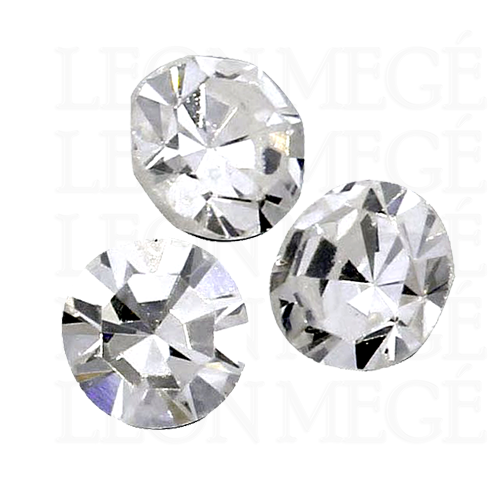
Single-cut diamonds are not for single people, just as the Full-cut diamonds are not popular with those full of, well.., you know what.
Single cuts, aka Eight Cuts, are small round diamonds with octagon-shaped tables, usually less than 10 points. There are eight crown facets and eight pavilion facets. Altogether, there are 17 facets, or 18 if you count the culet. Early single cuts were octagonal. They became round in the 19th century, thanks to the invention of diamond bruting lathes. In the 1980s, automated cutting made it possible to scale a full-cut diamond to a minuscule size. This automation made Single Cuts obsolete, and the Full Cut Brilliants replaced them.
However, modern precision-cut single cuts are still used in ultra-high-end jewelry and luxury watches, thanks to their superior brilliance.
The Story of Single cut
The Single Cut is one of the oldest diamond cuts. It is a very simple cut, essentially an upgrade from the Table Cut, which the Point Cut preceded. The Point Cut diamond is a naturally formed octahedron crystal that is polished but not faceted. With the advancement of diamond cutting techniques, the square Table cut gave way to the octagonal Single Cut.
Single Cuts rose to prominence in the 1920s. They were common accent stones in Art Deco pieces that extensively used antique-cut diamonds.
They are easy to tell apart – the Modern Single Cuts do not have open culets.
Antique diamonds were cut by hand under dim light, so they were malformed, ill-proportioned stones with uneven facets and poor symmetry. Some think this was the secret of their charm, but others disagree. Antique Single cuts are mostly used to fill up tight spots in vintage jewelry.
Modern Single Cuts are fashioned using high-precision technology. They have perfect symmetry and command a premium price.
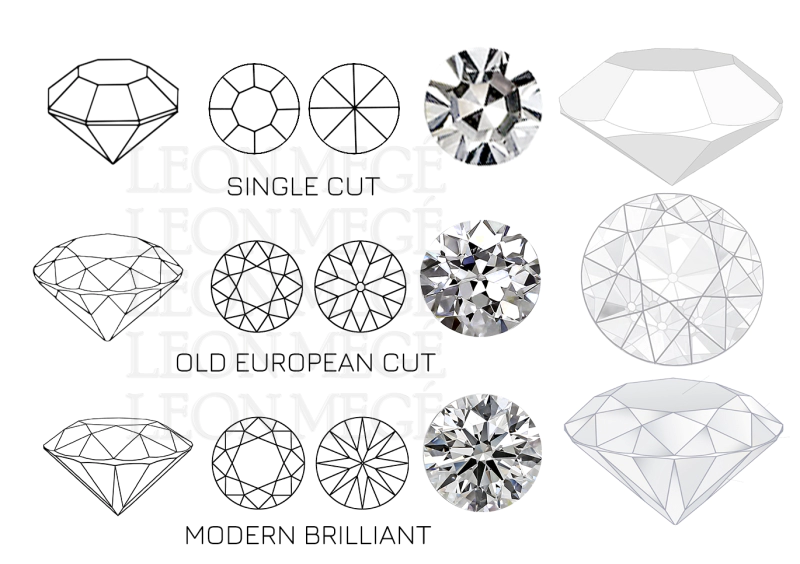
As the diamond’s size decreases, its facets shrink so much that reflections blend into a single light point. In other words, they lose their brilliance, which is the diamond’s ability to blink. The facets of single cuts are three times larger than those of full cuts and provide superior brilliance when the stone sizes drop below 1.2 millimeters. Single-cut diamonds are used in luxury watches, pave in ultra-high-end jewelry, and as accents for vintage cut diamonds. They burst with brilliance and fire. They form a repeating pattern of facet reflections, giving micro pave a fabric-like texture. Using single cuts in modern bridal jewelry is unnecessary because they are more expensive and do not match the rest of the diamonds. Full-cut diamonds with 56 facets are a better option.
Antique pear
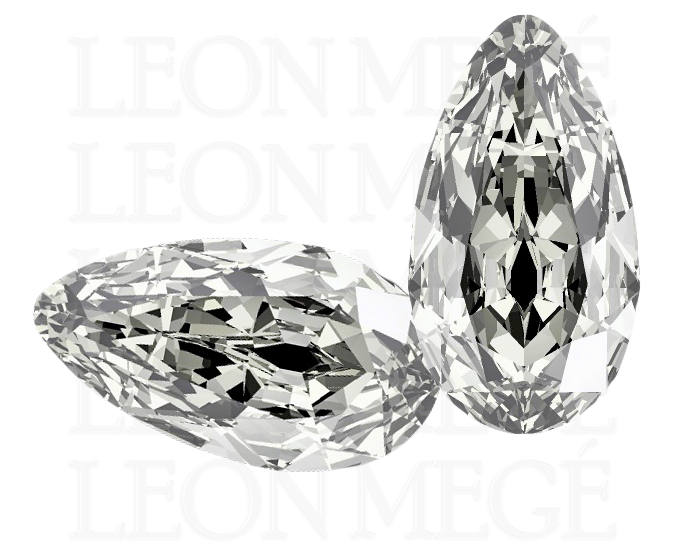
The first Pear Shape was invented in the mid-15th century by a Flemish cutter, Lodewyk van Bercken. The cut was a variation of a Rose Cut but with a point.
The True Antique Pear is not Briolettes or Rose Cuts. Instead, it has tables, crowns, and pavilions. Its point is usually blunted or rounded, and it has large open culets.
They are hard to come by; if you ever find one, do not let the marvelous stone out of your sight.
Moval
Often creating an illusion of a larger size, the Moval or antique marquise shape is the universal symbol of opulence and glamour. Moval is a gracefully elongated shape that straddles an oval and marquise. This rare and desirable diamond cut is typical of the Art Deco period.
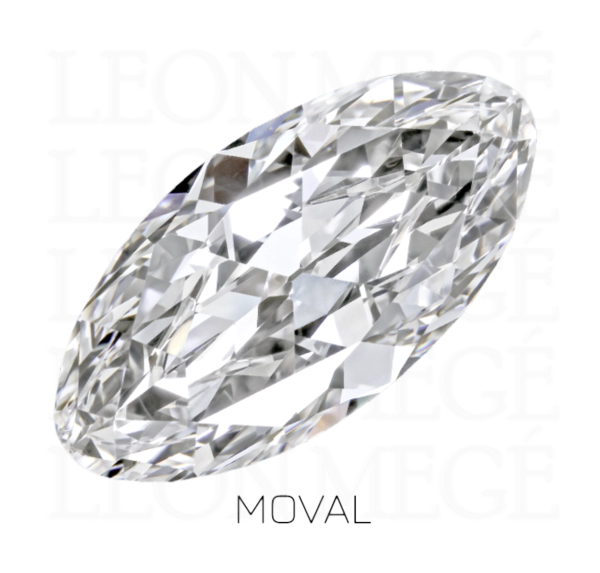
Peruzzi and Mazarin Cuts

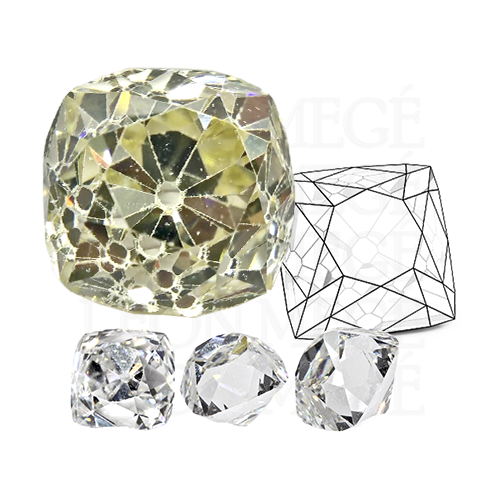
Created by Venetian polisher Vincent Peruzzi, the Peruzzi cut was one of the first “brilliant cuts” and is considered one of the oldest diamond cuts in existence. Peruzzi has 33 facets and is an ancestor of the modern brilliant-cut diamond. Peruzzi modified and improved the Mazarin cut by adding 16 more facets to create a diamond with superior brilliance.
The two obscure diamond cuts, Peruzzi and Mazarin, gave birth to the French cut through gradual transformations and improvements.
The early brilliant diamond cut created in 1650 was named after Cardinal Mazarin, who was very fond of diamonds.
Portrait Diamonds
A portrait-cut diamond resembles a thin sheet of ice with step facets surrounding a large, open table. The shallow cut was typically set over miniature portraits and tiled paintings. The portrait cut is similar to the Polki diamonds and has a similar faceting.
Polki diamonds originated in India long before the Jews of Antwerp developed modern diamond cutting. Polkis kept the original rough shape and had an unfaceted, polished surface.
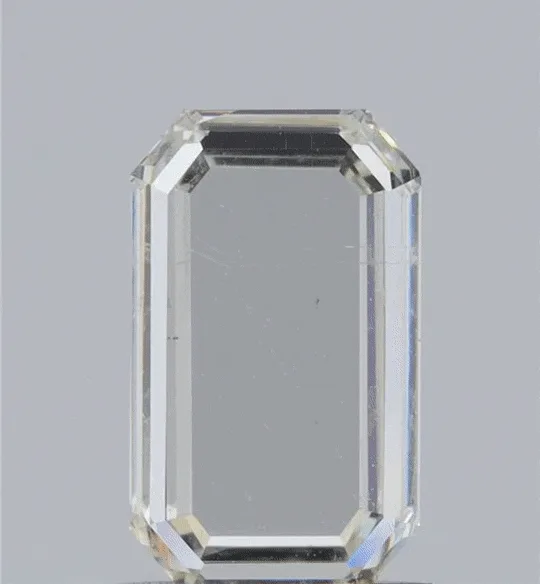
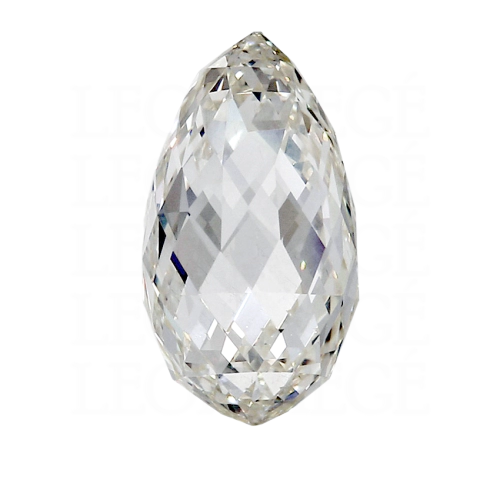
Briolette
Europeans learned about briolettes in the 1600s when Jean-Baptiste Tavernier brought some from India to France. Louis IV, Marie Antoinette, Henry Philip Hope, and Persian and English royalty owned and admired diamond briolettes. Unfortunately, briolettes were the first casualties of recutting old stones into modern cuts, depriving the world of the ancient art form because the cut was deemed inefficient and wasteful.
It wasn’t until the Victorian and Art Deco periods that briolettes rose to prominence again, adhering to modern standards. Briolettes returned to the spotlight with a renewed appreciation for history, used by prominent designers spearheaded by Maestro Mege. Briolettes subtle beauty is proving to be timeless.
Side stones are diamonds or, less often, gemstones that straddle the center stone in three- and five-stone rings. They are also used in earrings as matched pairs.
Side stones are judged by how well they are matched to each other in size, shape, color, faceting pattern, and, to a lesser degree, their clarity. The carat weight is secondary because it usually does not correspond to the stones’ dimensions. Side stones must complement the center stone they are supporting without overshadowing it.
Side stones are usually one color grade lower than the center stone. Elongated side stones such as straight baguettes, radiants, emerald cuts, ovals, and marquises can be positioned parallel to the finger (North-South) or across the finger (East-West). Common diamond cuts, such as rounds, pears, emeralds, etc., can be both centers or sides. Specialized cuts such as shields or bullets are used exclusively as side stones.
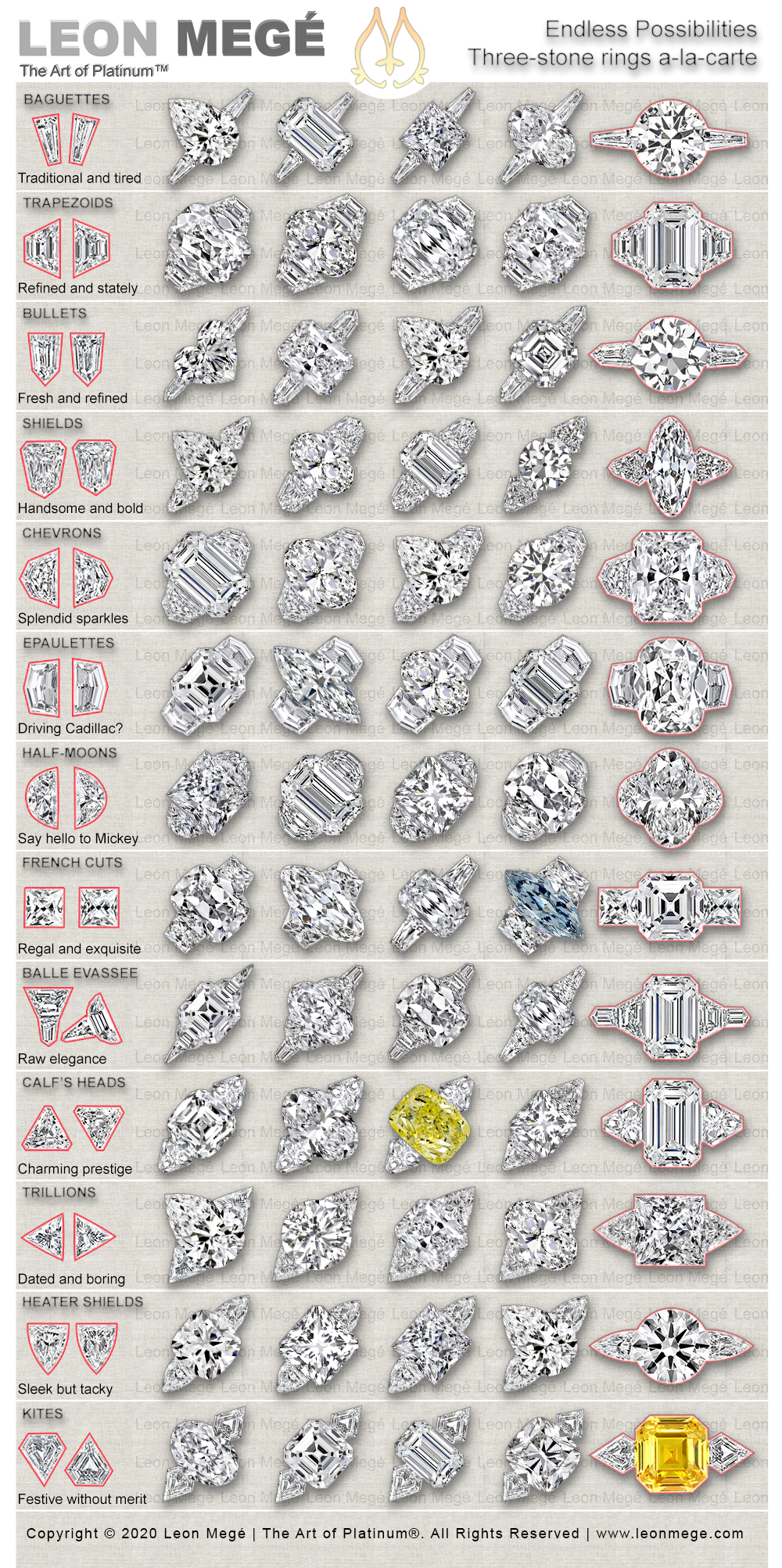
Diamond Baguettes
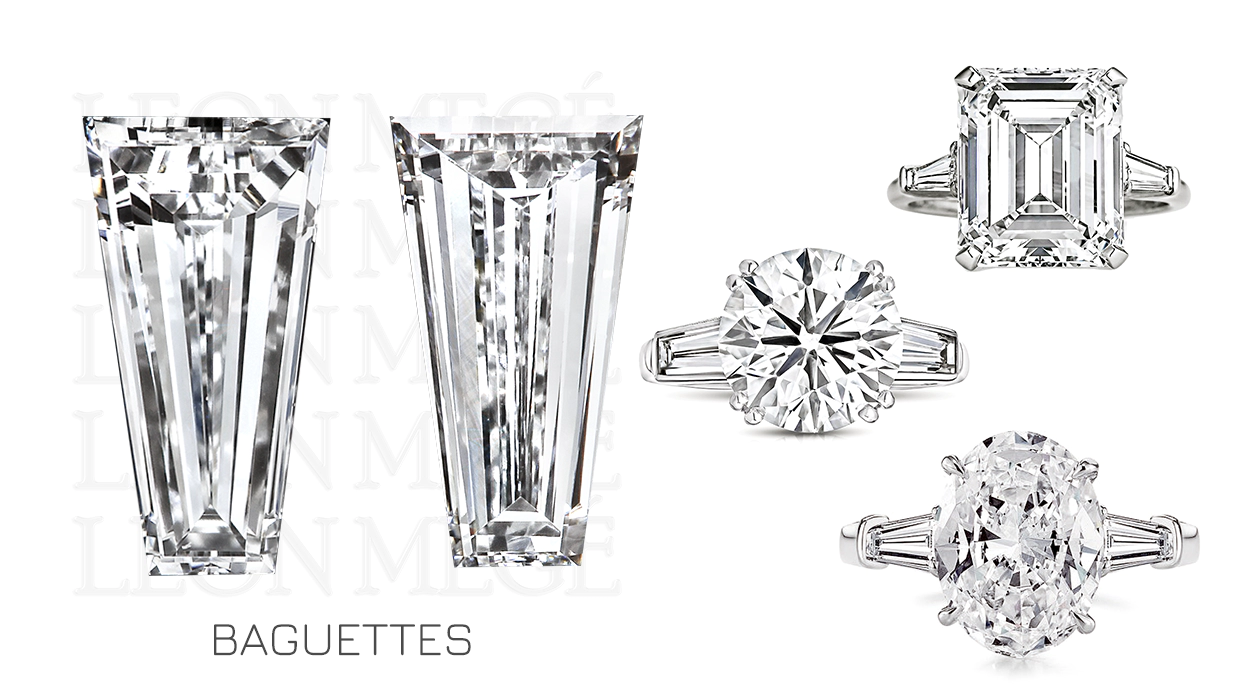
Baguettes are the most common side stones in three-stone rings. At the dawn of the 20th century, baguettes were recognized as a distinct diamond cut. Until then, the slender shards of a diamond crystal left after cleaving a diamond were discarded as unusable.
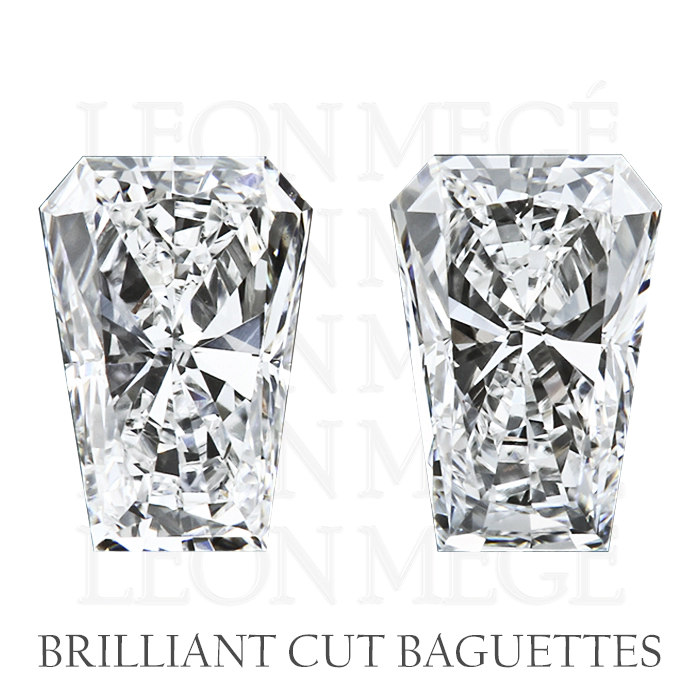 There are two types of baguettes: straight and tapered. The short sides of most baguettes are parallel to each other. Straight baguettes are rectangular. Square step-cut baguettes have equal length and width. They are called “carré,” which means “square” in French.
There are two types of baguettes: straight and tapered. The short sides of most baguettes are parallel to each other. Straight baguettes are rectangular. Square step-cut baguettes have equal length and width. They are called “carré,” which means “square” in French.
A brilliant-cut baguette is a novelty. Technically speaking, a brilliant-cut baguette is an elongated princess cut.
A straight baguette is similar to an emerald cut but with fewer facets and unbeveled corners. In a three-stone ring, straight baguettes can be positioned in both North-South and east-west directions. They are usually staggered next to each other to form a ladder descending from the center stone.
The tapered baguettes’ width gradually decreases toward one end. Its longer sides angle inwards at approximately 5 to 8 degrees. The tapered baguette’s wider end abuts the center stone, while the narrow end points toward the shank. Sometimes, a baguette three-stone ring is called a solitaire because, structurally, the baguettes are parts of the shank. Tapered baguettes and bullets are set lower and positioned at a steeper angle.
Diamond Bullets

Bullets are elongated pentagons with two long sides and two short ones. One short side is terminated with a sharp point. They are similar to baguettes, which are often turned into bullets. The V-shaped tip allows for a better transition into the shank and for the shank to appear thinner.
Typically, the bullet’s point is protected by a V-shaped prong to underscore its exquisite shape. There are several kinds of diamond bullets: straight or tapered, step-cut or brilliant-cut, long or short.
![]()
Each bullet style has its fans and advantages, depending on the specific application. Tapered bullets, like tapered baguettes, are generally more pleasing to the eye. Bullets combined with diamond half-moons or diamond trapezoids make the two most popular five-stone ring styles.
Brilliant-cut bullets are less common and used for brilliant-cut centers or colored stones and colored diamonds.
Step-cut bullets compliment an Asscher or emerald-cut diamond.
Straight bullets were common during the Art Deco era, often bezel-set to highlight their shape. Elongated bullet shields are bullets with blunted or clipped corners. They are usually larger stones.
Cutting smaller diamonds as bullet shields is not practical. The regular tapered bullets will do the job. The trimmed corners make room to blend in prongs holding the stone.
Diamond Trapezoids
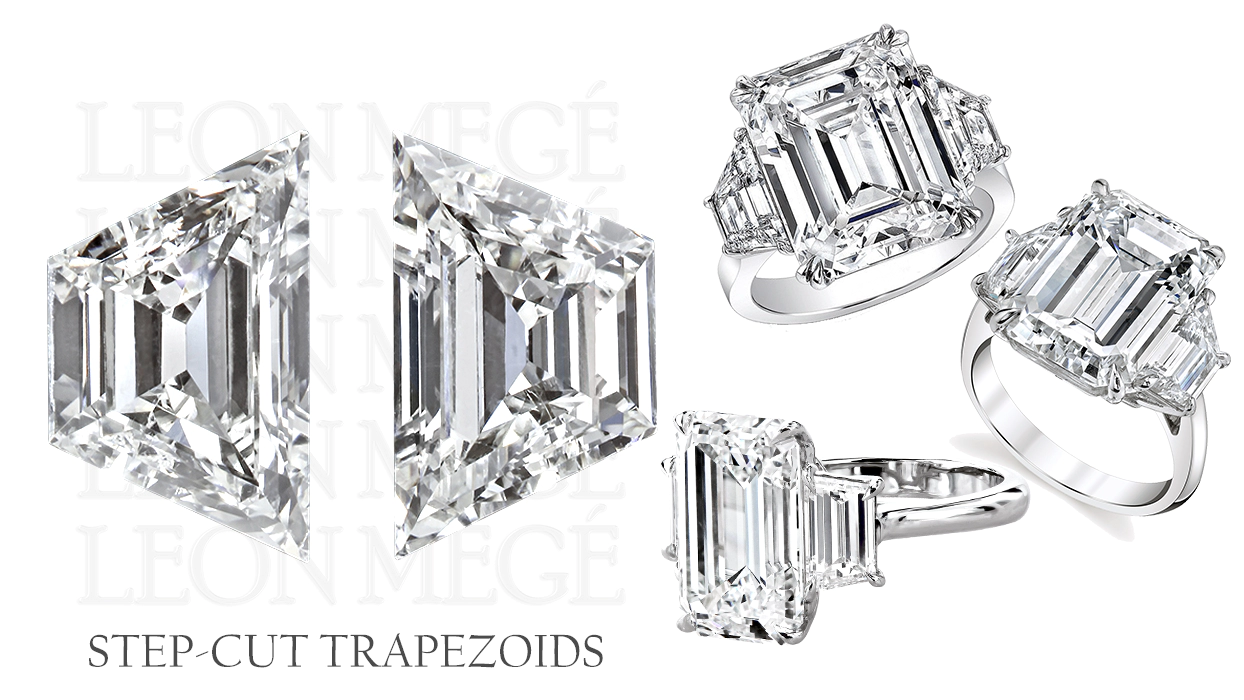
Trapezoids or “traps” are modified straight baguettes slanted on both ends to form a trapeze. When the trapezoid is angled down next to the center stone, tapering has a vanishing effect. Trapezoids need a large center stone to lean on. When the center stone is too small, it has to be elongated to accommodate the trap’s length.
Step cut trapezoids work great with an emerald or an Asscher cut. Brilliant cut trapezoids are usually matched with brilliant-cut diamonds such as radiants, cushions, and princess cuts. They work well with colored diamonds and colored stones.

French cut trapezoids work well with antique cuts such as the Asscher’s or Old Miners. Crescent trapezoids’ longer sides are caved in to fit flush against a rounded stone. The sharp points of the crescent are prone to breaking. In most cases, the curve is unnecessary. A skilled jeweler knows how to set the three stones tight without the need for a caved-in diamond side.
Diamond shields
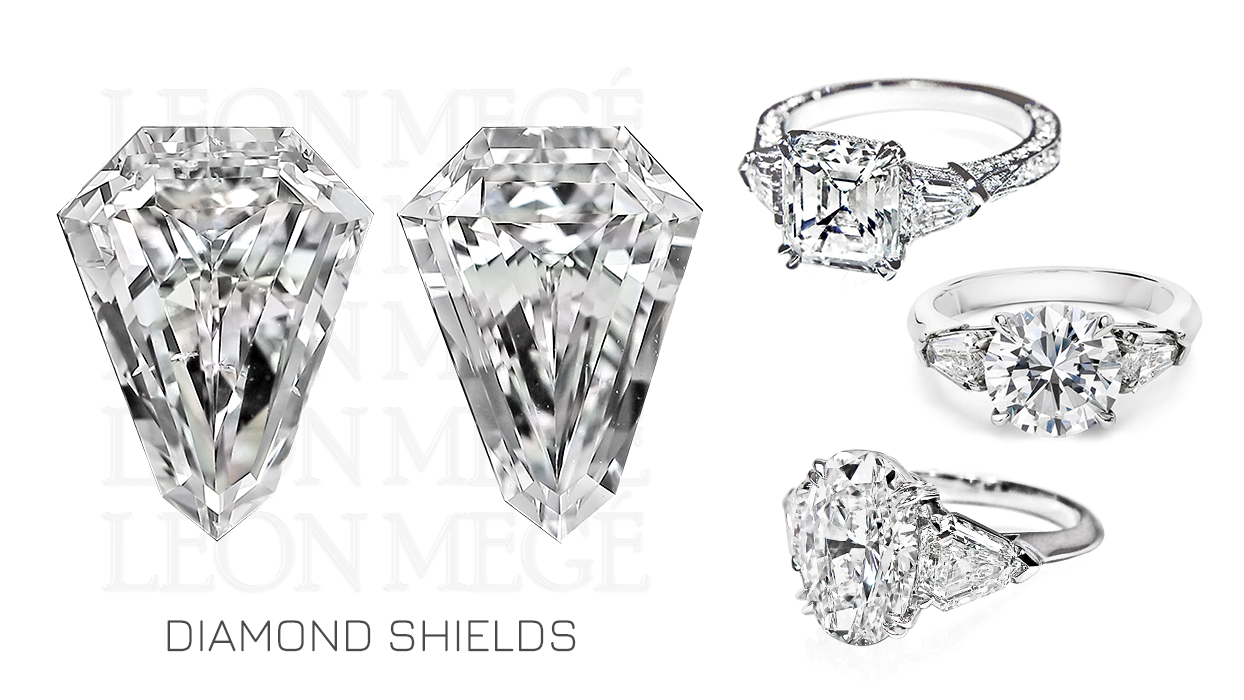
Shields are triangular diamonds with two clipped corners and a third finished as a V-shape. Their proportions vary from wide to elongated. Some shields resemble chubby diamond bullets, and some look like chevrons with blunt corners.
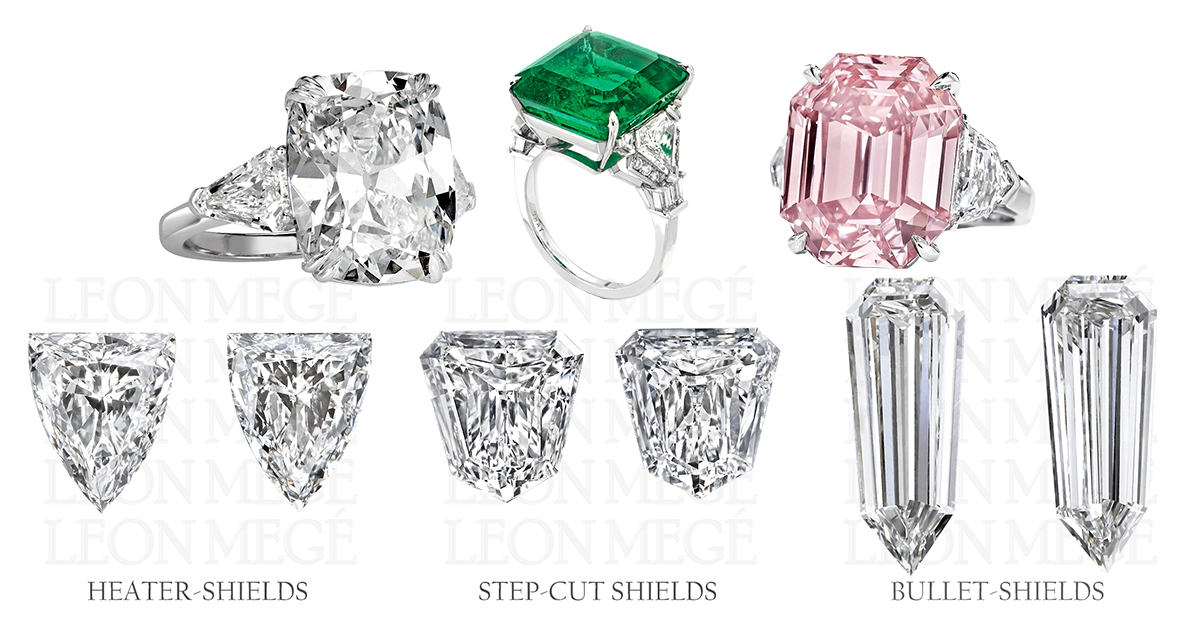
The most common and eye-pleasing shields are slightly elongated. Small shields can substitute for bullets. They are beautiful, versatile, and can be paired with virtually any center stone.
Step-cut shields work best with step-cut center stones. Brilliant-cut shields are typically paired with brilliant-cut centers and colored gemstones. Heater shields present an opportunity to reuse broken marquise diamonds. Marquise points are prone to chipping, rendering the whole diamond unusable.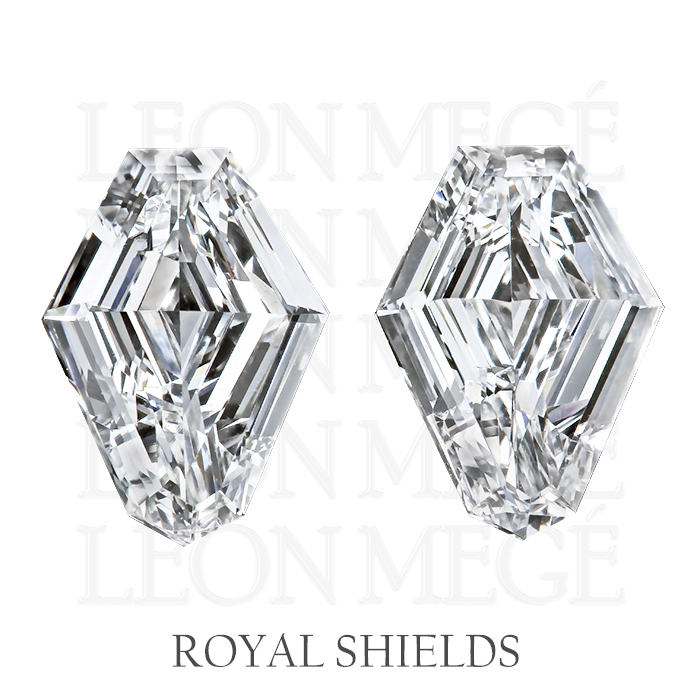
Diamond cutters saw off the broken tip, giving the stone a clothing iron shape, hence the name. These recycled marquises lack the elegance of a pear-shaped diamond, which would be a better choice. Their crushed-ice brilliance makes them a poor choice for most diamond shapes, except for a princess cut. Royal shields are a rare and unusual step-cut, best paired with a round brilliant in the center.
Chevrons and Epaulettes
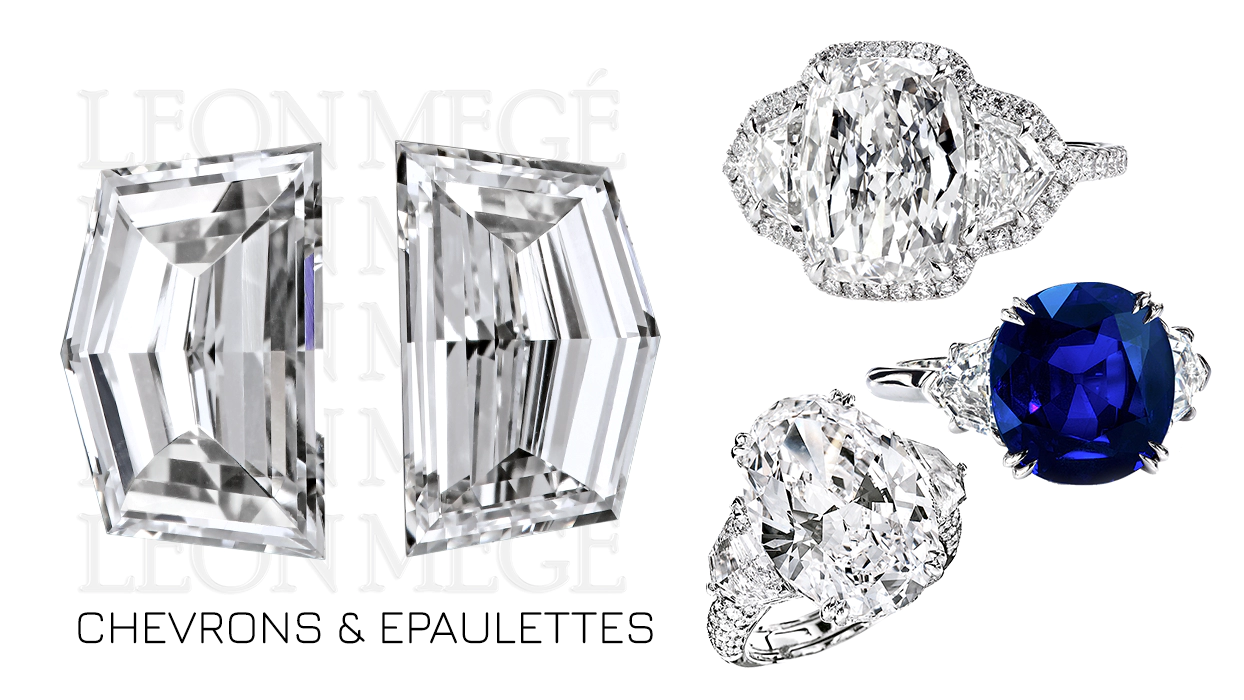
Chevrons and epaulettes (American epaulets) are five-sided diamonds with one long and four short sides. The distinction between chevrons and epaulette is the angle at which the sides meet. Chevron sides are well-tapered, and their point is typically 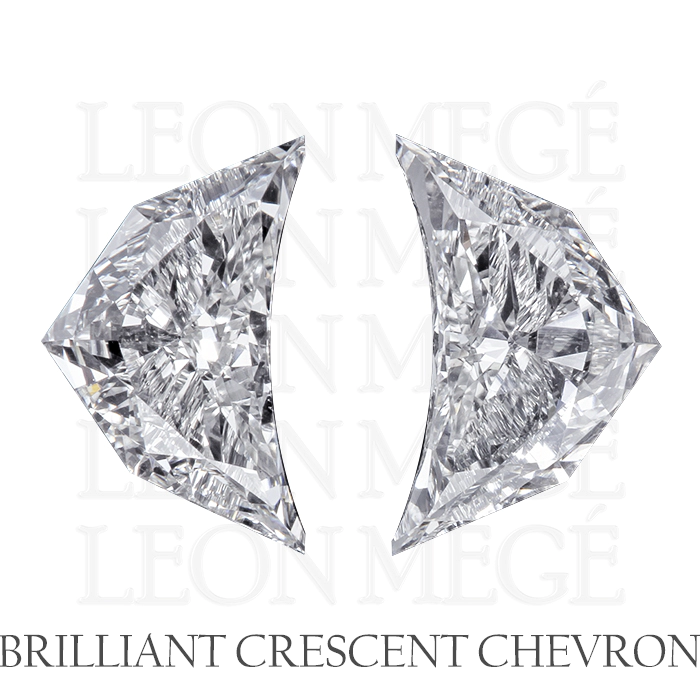 sharper than the point of epaulettes. Chevrons are more elongated with a length-to-width ratio of more than 1.0. In contrast, the epaulettes’ ratio is below one. Chevrons have a sharp point vs. an obtuse point on Epaulettes.
sharper than the point of epaulettes. Chevrons are more elongated with a length-to-width ratio of more than 1.0. In contrast, the epaulettes’ ratio is below one. Chevrons have a sharp point vs. an obtuse point on Epaulettes.
Chevron’s three points are close to the equilateral triangle, with its vertex angle less than 140 degrees. Step-cut chevrons can be used with any center stones. Brilliant-cut chevrons are sometimes confused with trillions. Brilliant cut chevrons are too flashy and tend to compete with the center stone they purport to enhance.
The Crescent chevron’s longest side is caved-in to better fit against a round, oval, pear, or marquise. Using a laser to indent a diamond seems impressive to an average person, but jewelers find this feature useless. What looks like a premium feature is, in reality, a creative way to carve out an inclusion. A skilled jeweler knows how to set all three stones tightly together without butchering diamonds.
Epaulettes are generally shorter and less angled than chevrons. The three furthest points of epaulettes form an isosceles triangle with more than a 150-degree vertex angle. Sometimes called Cadi or Cadillac because they resemble the Cadillac emblem, these stones have limited use. Unlike trapezoids, Epaulettes cannot be combined with bullets or tapered baguettes into the Balle Evasee Martini-glass flute. Brilliant-cut epaulettes are uncommon and not very attractive. Epaulettes can be useful for small fingers.
Half-Moon Diamonds
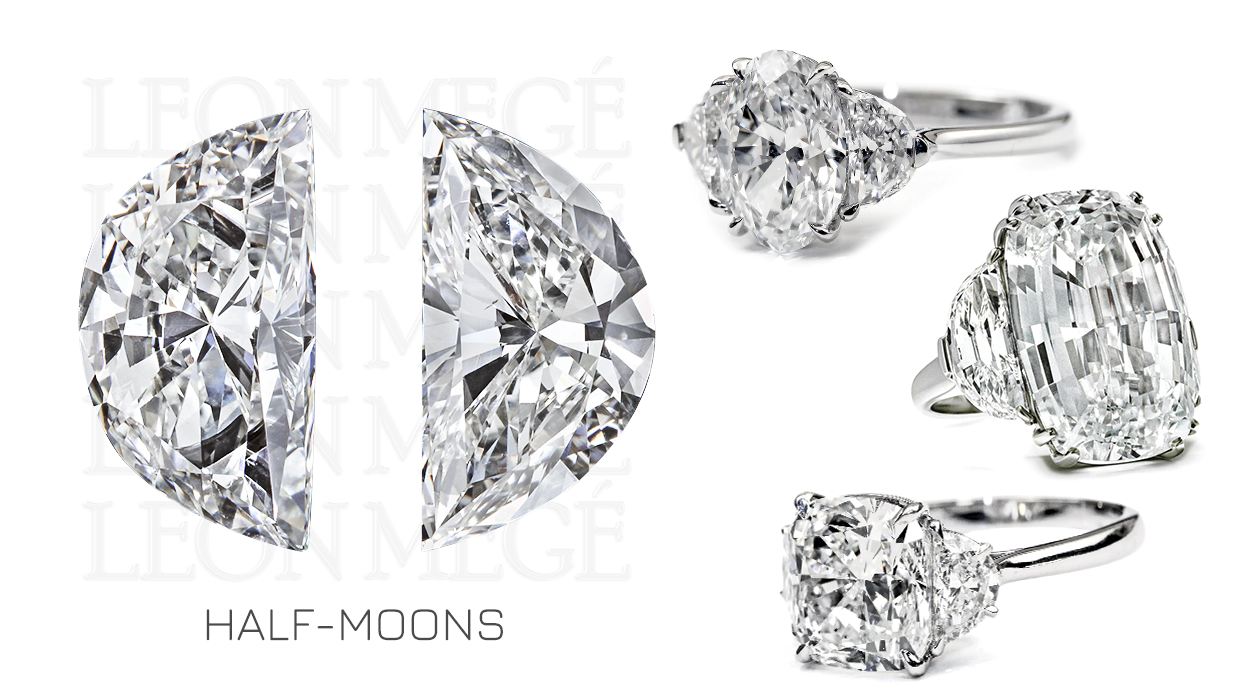
One side of a half-moon diamond is straight (the chord), and the other side is an arc. A half-moon diamond has the shape of a segment of a round or an oval diamond. A half-moon diamond can be skinny (the chord slicing less than half), full (semicircle), or fat (high-dome).
Skinny half-moon diamonds (those with a length-to-width ratio exceeding 2.0) look pleasant with large ovals and elongated cushion diamonds. They complement many diamond shapes, particularly cushions, ovals, and radiants. Fat half-moons look like Mickey’s ears and should be avoided. There is very little use for fat half-moons in fine jewelry except in drop earrings.
Step-cut half-moons are beautiful, but they are tough to find. Putting steps on a small diamond requires much patience and precision. On occasion, we see step-cut half-moons fashioned from emerald-cut stones. Those do not have an elegant arc of real step-cut half-moons. These step-cut half-moons are not attractive and should be avoided. Crescent-shaped half-moon diamonds with a scooped long side are usually lifeless and dull.
French Cut Diamonds

The story of French-cut diamonds starts with the never-ending search for a diamond cut so unique that only a few knew it exists. The French cut is an antique diamond cut with a high crown and deep pavilion. The traditional old-style French-cut diamonds are cut from rough, while the modern version with a flat crown is typically cut from baguettes.
The traditional French cut has a small rhombus-shaped table rotated 45 degrees to the girdle. The French-cut crown has nine facets, four of which are triangles pointing to each corner. These facets give the stone its unique four-pointed star look. The pavilion has only four facets.
French cuts date back to the 14th century but enjoyed renewed interest in the late 19th to early 20th century. Sometimes, it is confused with the Peruzzi cut, an obscure transitional cut that is a bizarre cross between French and Old Miner diamond cuts. Small French cuts are typically used in sets or layouts.
They mix well with other antique cuts, such as antique cushions and Asscher cut diamonds. French cuts are typically square or rectangular. There are modern versions of traditional French cuts in trapezoid or tapered baguette shapes. They are very popular with antique diamond cuts. One of our wildly popular ring styles, “Leon Mege MonCheri™” features tapered French cuts calibre.
Balle Evassee – The Queen of Side Stones
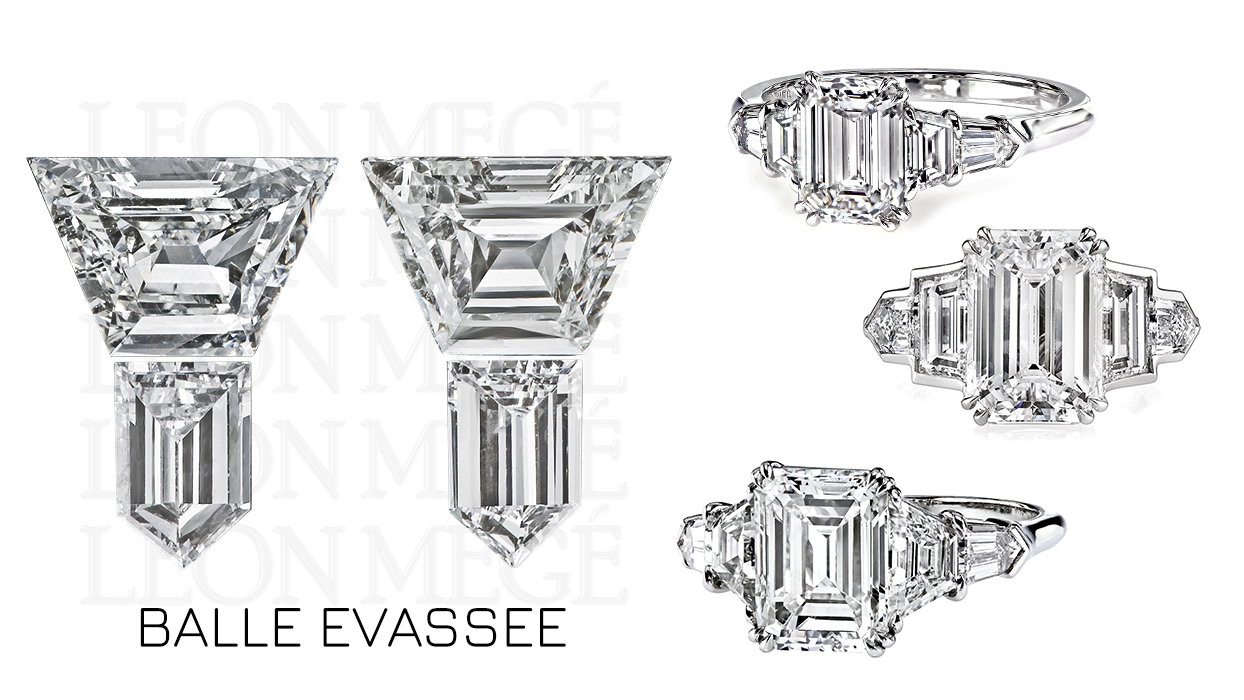
Balle Evassee (French for a “Bell Tutu”) is a combination of two stones, usually a trapezoid or a half-moon with a bullet. The iconic design achieves a dramatic effect of diamonds seemingly exploding out of the shank. The flare effect is achieved by putting two precisely calibrated stones together.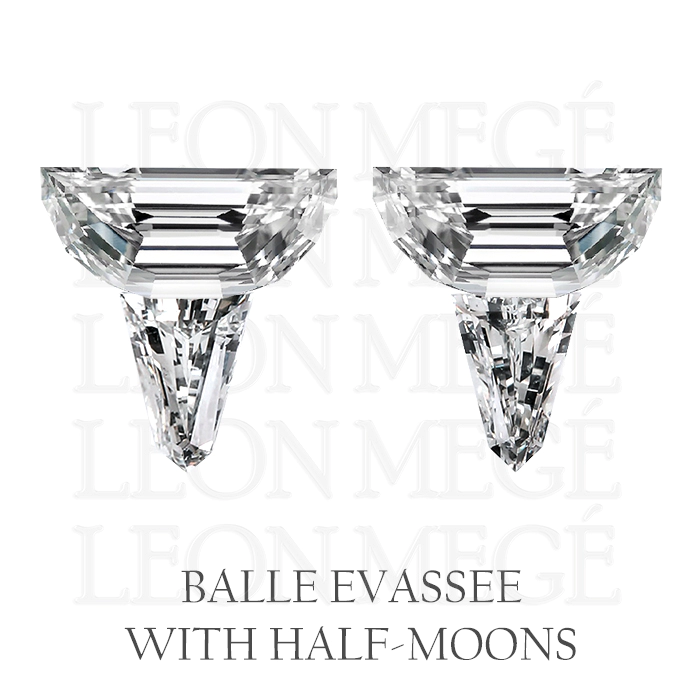
Balle Evassee makes a dazzling five-stone ring that can complement any diamond cut in the center as long as it is long enough. The result is guaranteed to be stunning.
Balle Evassee with half-moons can include both brilliant and step-cut versions, as long as the faceting pattern is proportional to the center stone. However, it is not recommended for those with petite fingers, i.e., US size four or less, especially when the center stone is large.
Kites, Aces, and Lozenges
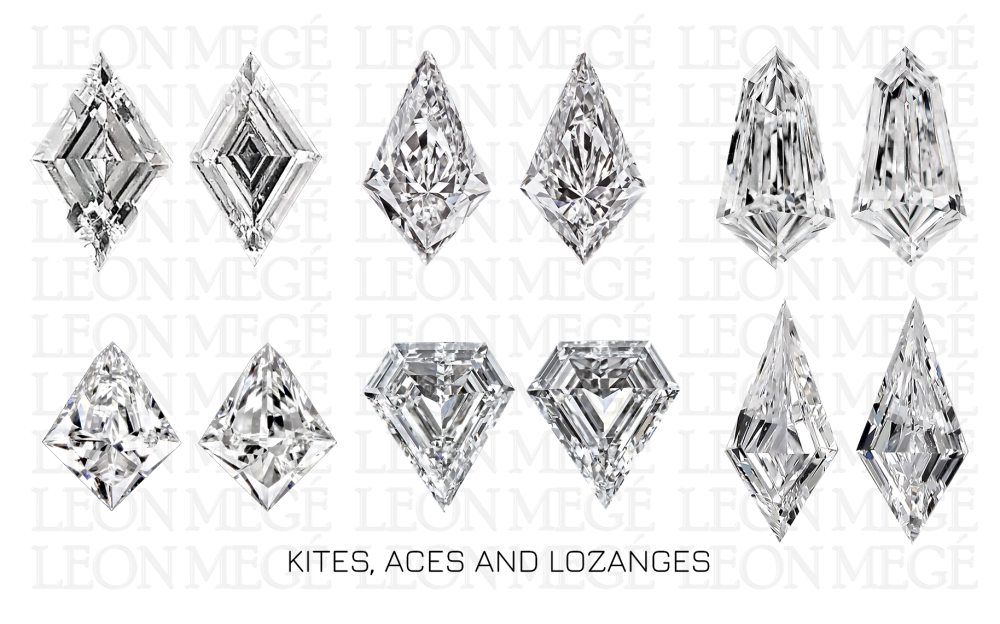
The ace-cut diamonds have four equal-length sides where opposite sides are parallel and opposite angles equal. The technical term for such a shape is the Rhombus. In popular culture, this is the shape of a diamond suit in a card deck. Kites have two longer identical-length sides and two shorter ones; the opposite angles are equal. Sometimes, the top of such stone is sliced off, turning it into a pentagon, but it is still called a kite. Diamond cutters are not mathematicians.
The Ace cut is rarely used in rings, and if it is, it is not as side stones but rather as accents, similar to pave diamonds. Most Ace cuts are step cuts; brilliant cut Aces are skewed Princess cuts.
Diamond kites have limited use in a ring. Even the step-cut kites are not considered elegant side stones. Pentagon kites are sometimes used as a substitute for diamond shields or pear-shapes. Step-cut pentagon kites are one chipped point away from being a shield. Matching pairs of kites often replace briolettes in drop earrings and fringe necklaces.
Trillions and Calfs Head Diamonds
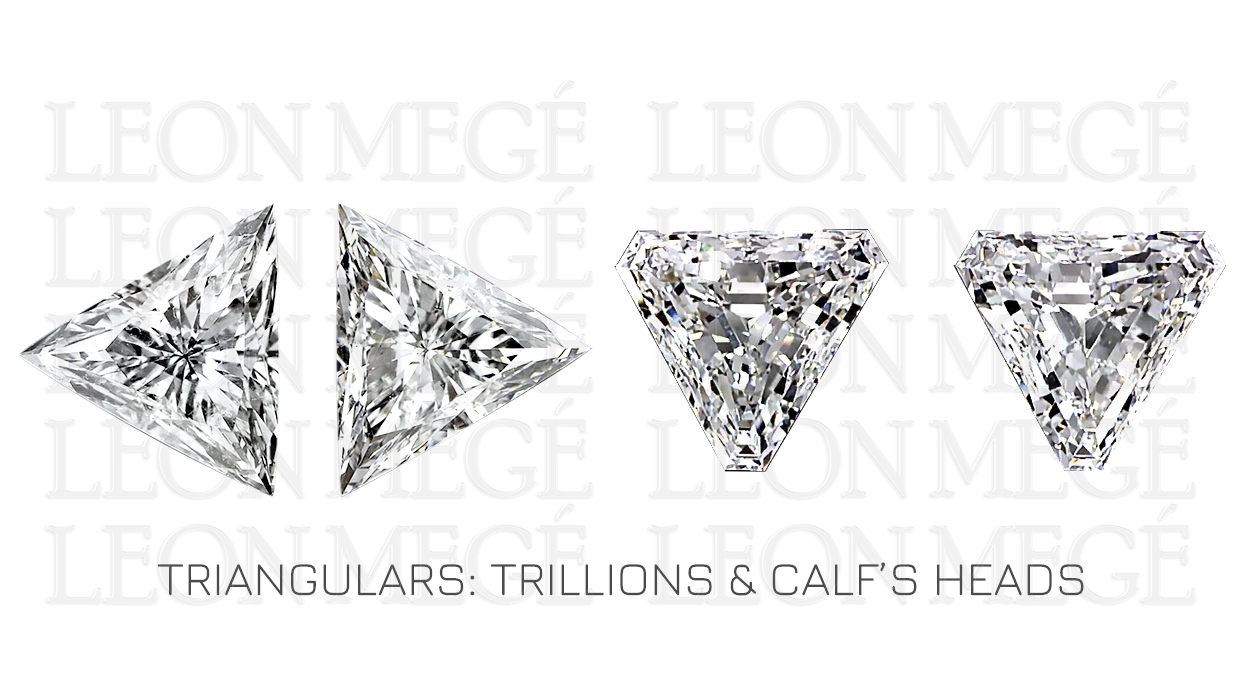
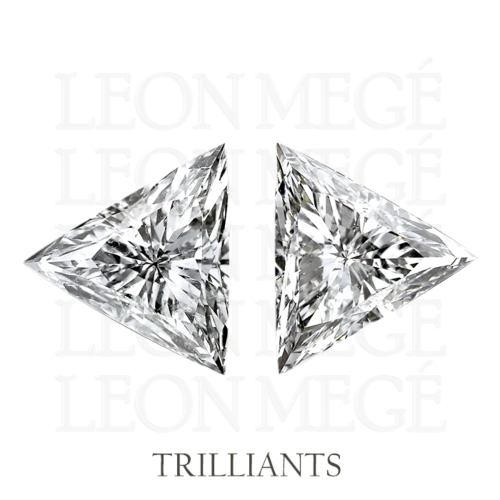
Thanks to the glut of shallow triangular rough called macle that is hard to polish into anything decent, trillions rose to popularity in the late ’60s. It is no surprise that the first triangular diamond was developed in Amsterdam. A trillion looks like something from the Twilight Zone, screaming, “Don’t smoke and cut” at the cutter. Trilliant is the brand name that gave us the trillion, a generic term for any triangular diamond.
For example, other brands have a patented triangular cut with completely straight sides called Trielle. Trillions are so-so choices, no matter “what condition your condition is in”
Wildly popular in the acid haze of the ’60s, trillions look dated and mildly tasteless today. Their points are vulnerable to chipping or shattering, the risk apparent during the diamond’s polishing and setting.
The unusual triangular step-cut diamonds with beveled points are called “Calf’s Heads.” Properly faceted, Calf’s Heads have more sparkle and fire than brilliant-cut trillions while retaining a noble twinkle of a step-cut diamond. Calf’s Heads run the gamut of proportions, so they should be selected carefully to match the center stone’s faceting pattern.
Brilliant cut calf’s heads look like trillions with broken tips. Recommendation – avoid.

A Wide Variety of Cushions

Cushions or diamond pillows of various elongations and faceting styles are fabulous side stones in a three-stone ring. Antique cut sides will match antique cut center stones. They could be an exciting option as side stones for modern cushions, emerald cuts, and even ovals. A cushion-cut diamond with a one-to-one ratio can be used with a round center.
Caesar is a relatively obscure cushion cut with mixed faceting. The crown has brilliant facets, while the pavilion usually has steps. Because of this “dual-personality,” the Caesar cut can be used with both step- and brilliant-cut center stones.
Sometimes the elongated Caesars are confused with other mixed-cut cushions such as Ashoka or Crisscut. However, the Caesar cut has a different faceting arrangement. It has a superior brilliance when compared side-by-side to Ashoka or other inferior mixed cuts. Caesar cut is not protected by any patent. Anybody can cut one, which makes the Caesar cut affordable. Caesar cut diamonds come in various length-to-width ratios – mostly elongated.
Hearts and Pears
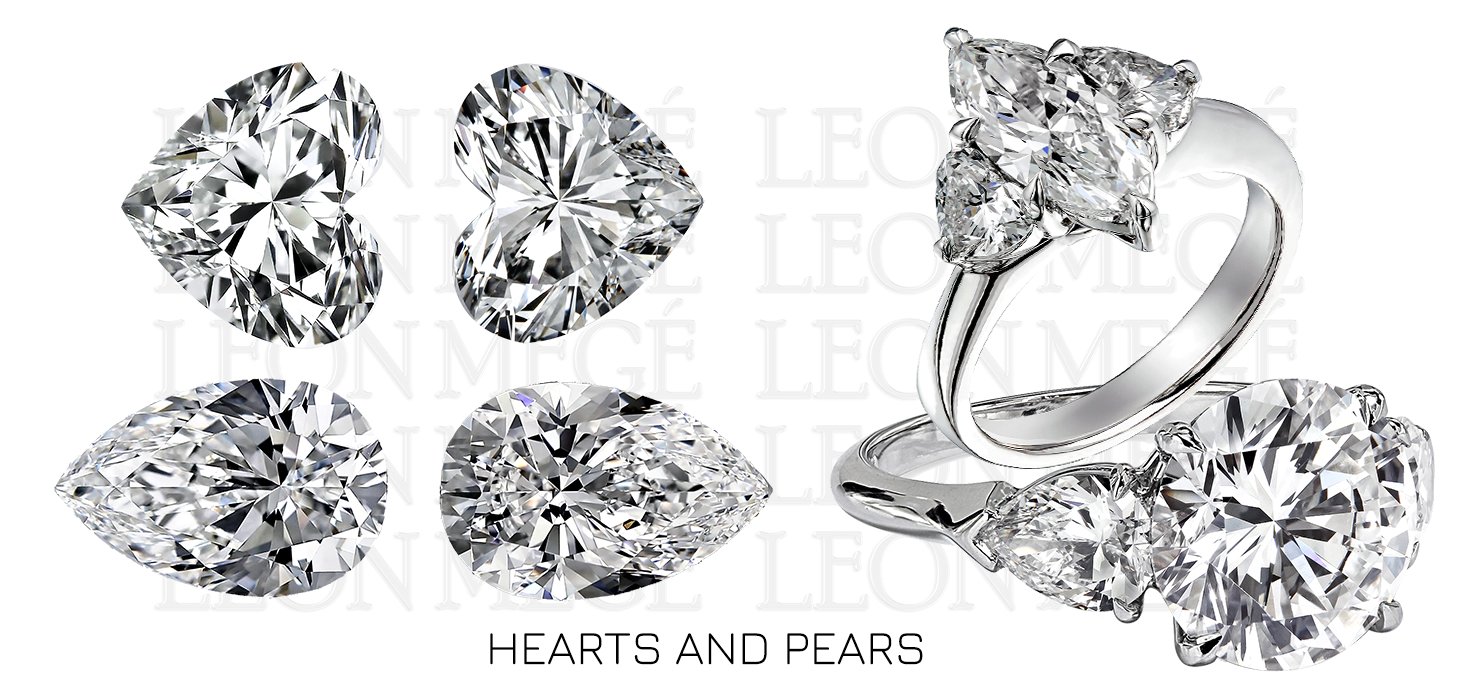
The pear-shaped diamond has brilliant facets, but rare vintage stones are step-cut. The cut may seem modern, but the first one on record dates back to the 15th century. A round stone with two pear shapes is one of the most elegant combinations of stones in a three-stone ring category.
The heart-shaped diamonds are exceptional. There’s no other diamond cut with more symbolism built into its shape. They are a perfect fit for a round, oval, marquise diamond. They look great next to colored cabochons, and they are fantastic flanking a pearl.
Trinity Three-stone Ring
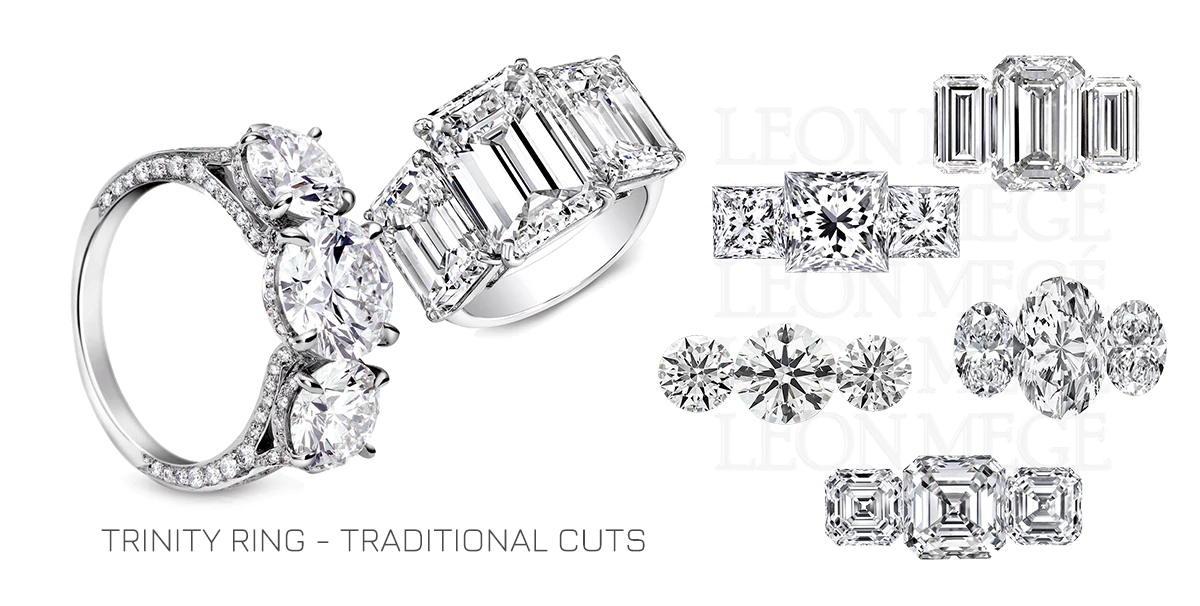
Rounds, Emeralds, Radiants, Ovals, Marquises, and Princesses can be both the center and side stones of a three-stone ring. Used as side stones, they are usually matched with the same-shaped diamond in the center.
Round side stones make any center diamond, except the round center, look like it grew Mickey’s ears. Asscher side stones can be combined with an Asscher or with a chubby emerald cut. Radiant side stones can be found next to a Radiant or a large Princess cut in the center. Princess cuts go together only with a princess cut. Oval side stones match the oval center and pretty much nothing else. Single Marquises as side stones are horrific, but they make a lovely cluster to accent any brilliant-cut center stone in combination with other marquises and pears.
